In Plain Sight: How White Supremacy, Misogyny, and Hate Targeted the Star Wars Sequel Trilogy and Won
C/W: This article contains information about white supremacist groups, racist hate, misogyny, antisemitism and sexual assault, including quotes and descriptions about rape, racial slurs, and violence against women.
PLEASE BE ADVISED: If you see an * next to links in this article, they will direct to an alt-right associated YouTube channel, a white supremacist website or blog, or a male supremacist website or blog. These have been included for educational purposes only. Please click at your own discretion.
Note: Highlights of this article and additional insights are available as a podcast.
Part I: The Industry of Outrage, Gamergate and #BoycottStarWarsVII
Part II: You Are Not Immune to Propaganda
Part III: Have We Learned From Gamergate?

Since December 2017, pop culture news has been overcrowded with the same narrative: Rian Johnson’s Star Wars Episode VIII: The Last Jedi has divided audiences.
Despite a 90% approval rating from critics and an A CinemaScore, we can’t stop talking about how The Last Jedi is a polarizing film that has allegedly alienated fans en masse and sent Disney’s multi-billion dollar juggernaut in an unsatisfactory direction.
Creatives involved with Star Wars projects have even commented on the hate against the film. For example, Ron Howard, director of Solo: A Star Wars Story, took to Twitter to respond to comments blaming dislike of The Last Jedi on Solo’s underwhelming box office performance shortly after the film’s release in 2018.
Actor Anthony Daniels, best known for his role as C-3P0 in the Star Wars franchise, noted in his memoir “I Am C-3P0” that after encountering the hate towards The Last Jedi on YouTube, he was “genuinely sad” that fans “felt their loyalty had been slighted.”
And in the lead up to the release of the final film in the Skywalker saga, Star Wars Episode IX: The Rise of Skywalker, director JJ Abrams acknowledged the animosity towards the franchise’s eighth installment by suggesting that fans didn’t want to be told that what they love about Star Wars “doesn’t matter.”
The Star Wars Episode VII: The Force Awakens director then went on to release a film that, according to Time Magazine, “feels as if Abrams read every critical tweet in [Rian Johnson’s] mentions from the last two years and answered each one, scene by scene.”
However, even though The Rise of Skywalker addressed “fan” concerns, the Skywalker saga ended with a whimper. It obtained the lowest critic score of any Star Wars franchise film on record at 51% and received a lukewarm reception from the general audience with a CinemaScore of a B+. After its release, Disney and Lucasfilm seemingly turned away from the sequel trilogy to focus on new opportunities on Disney’s recently launched streaming service, Disney+.
To the majority of people who decide to spend two hours invested in the Galaxy Far, Far Away, the Star Wars sequel trilogy films are likely fun popcorn flicks that added little to the saga overall. In the end, the sequel trilogy is an ode to the past — a chance to recapture the energy of 1977 and reclaim the heroes of a time that the world is quickly passing by.
Moreover, the failing of The Rise of Skywalker to provide a satisfying conclusion to the Skywalker Saga for fans and casual viewers, alike, will likely make the sequel trilogy the least consequential addition to the franchise. While there is value in nostalgia and honoring the past, the reality of this particular situation carries with it something much more sinister that is easy for most people to miss.
The Last Jedi forged an ambitious path forward in a time when governments around the world were regressing into fear and hatred, spurred on by the growth of progressive politics and rise in minority populations. Johnson took a beloved cornerstone of western culture and turned it on its head, much like Star Wars creator George Lucas had done with the franchise’s prequel trilogy.
In the film, Johnson questions the beliefs and principles of the saga’s legendary heroes and lore. The journey of each character is defined by a failure that could have been avoided if characters from different races, genders, and age groups simply communicated with one another. In one scene, he sends iconography of the past up in flames, only to imply that the parts worth saving would be passed on to the next generation.
This next generation includes a woman whose strength and resourcefulness are attributed to her lived experiences and not a power from her lineage; a resilient fighter, played by British-Nigerian actor John Boyega, who had fought against all odds to free himself from an oppressive regime; and the next leader of the Resistance heroes, played by Guatemalan-American actor Oscar Isaac.
At the beating heart of the film is a courageous mechanic Rose Tico, played by Vietnamese-American actress Kelly Marie Tran. Rose’s ceaseless compassion and drive to dismantle inhumane powers around her culminate in the most critical line of the film: That to truly defeat those who seek to subjugate you, your true power is saving what you love, not destroying what you hate.
These themes and characterizations make the The Last Jedi a film that dares to move culture into a more diverse and hopeful future. And in response, the film has been faced with an organized hate campaign against it.
Most publications discussing hate against The Last Jedi are quick to note that the backlash has manifested into racism, specifically against Tran and Boyega. Esquire has arguably gone the farthest in its critique against The Last Jedi hate, attributing the worst of the negativity to “neckbeards,” a belittling term for terminally online men who hold misogynistic views.
However, it is not enough to call these people “fans” simply pushing back against The Last Jedi’s themes of diversity or change. Nor is it enough to label them “trolls,” “cry babies,” or the often misused term “incels.”
We need to talk about the fact that almost 40% of negative YouTube videos mentioning The Last Jedi are from radical right wing or alt right accounts. These accounts have also dedicated their channels to hate campaigns against Captain Marvel star Brie Larson, former SNL cast member Leslie Jones, and feminist YouTuber Anita Sarkeesian.
We need to discuss how the leaders of hate mongering against the film are radical conservatives including Ben Shapiro, founder of right-wing website The Daily Wire and former editor-at-large of Breitbart News. Breitbart is notably responsible for pushing alt right ideology mainstream.
We need to discuss how the hashtag campaigns calling for fans to boycott Solo: A Star Wars Story over hatred of The Last Jedi are led by bloggers who spread white supremacist ideology under the cover of pop-culture reporting.
We need to discuss that the racist #BoycottStarWarsVII hashtag aimed at The Force Awakens actor John Boyega was started by members of an organization designated as a hate group by a leading United States civil rights organization, yet was written off as mere internet trolling. This kickstarted a slew of racist harassment against Lucasfilm employees, authors and actors that made Star Wars fandom a hot bed for alt-right recruitment in the ongoing 21st century “culture wars.”
We need to talk about how this so-called “fan backlash” is part of a larger movement to change and control culture put into motion by former White House Chief Strategist, Steve Bannon, in 2014. And it was a movement that successfully led to far right governmental shifts in the United States, the UK, India, Italy, and Africa.
Leveraging over one million tweets and greater than one thousand YouTube videos, this article will track the successful rise of radical right wing hate, white supremacy, and misogyny in fan spaces starting with Gamergate and leading up to The Rise of Skywalker.
This article is an analysis of the closely connected networks that enable hate to spread from influential white supremacist groups to mainstream YouTubers. It is a warning about the dangers of apathy and lack of education around organized hate in highly evolving technological spaces that will only continue to develop at a faster rate. But, most of all, this article is a plea for any entity that has enough power to control a narrative — whether it be major corporations like Disney or entertainment journalists at Vanity Fair — to be aware of how hate is designed to manipulate those narratives without most people ever realizing it.
This is the full story of how organized bigotry latched itself onto the Star Wars sequel trilogy and won.
What Will Be Discussed:
I. Defining 21st Century Culture Wars: Gamergate, Cambridge Analytica, & The Rise of the Alt-Right
-Timeline of Outrage Media
-What is Gamergate?
-White Nationalism Targets the Star Wars Franchise
II. The New Gamergate: The Rise of Alt-Right Ideology in Star Wars Fandom
-Was “The Last Jedi” Polarizing?: A Twitter Analysis
-All Roads Lead to YouTube: An Analysis
-The Star Wars Alt-Right Recruitment Problem
III. How Far Right Hate Turns Into Fact
-The Danger of “Click Bait” Headlines
-Socks, Bots, and Super Users
-Hashtags and Boycotts
-Lack of Education About the Dangers of Online Conversation
IV. The Generational Cost of Hate: The Alt-Right’s Successful Political Attack against Progressive Culture
-The Targeting of Progressive and Diverse Creatives
-Mission Completed: The Rise of Skywalker Retcons The Last Jedi
V. What We Never Learned From Gamergate
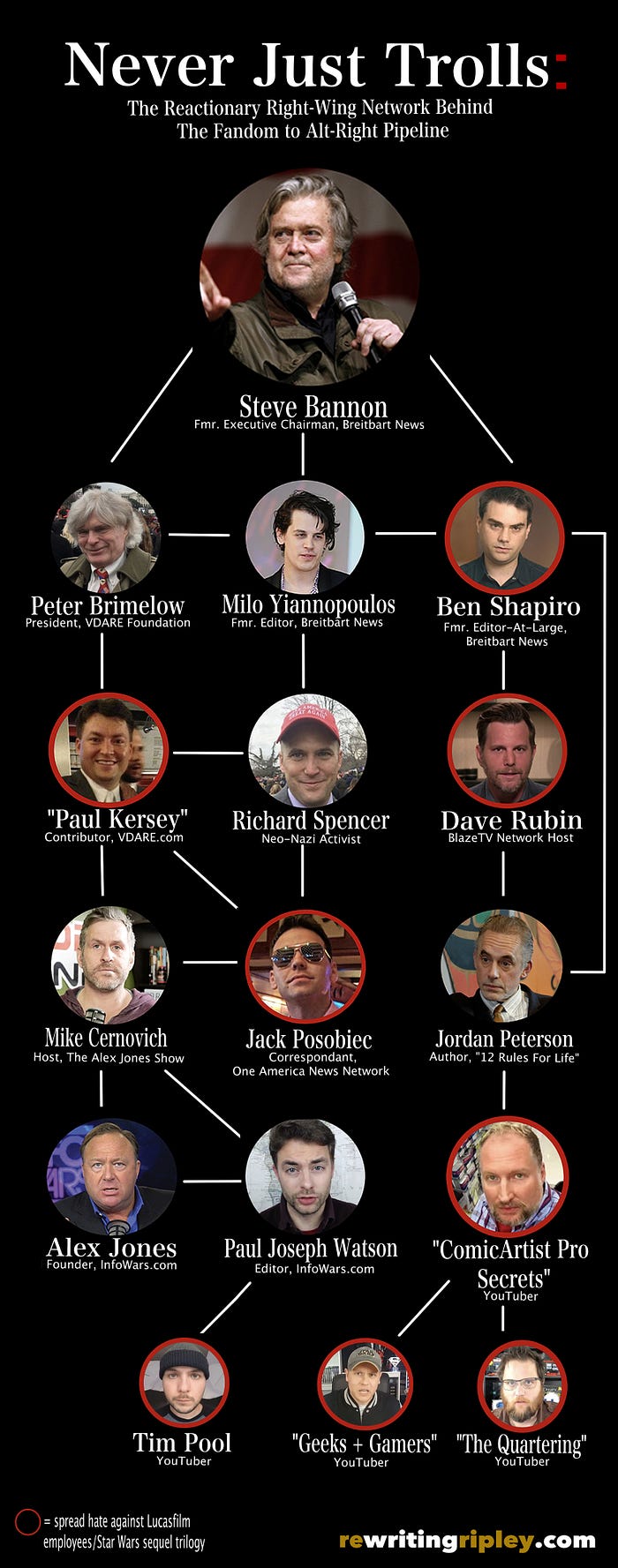
Defining 21st Century Culture Wars: Gamergate, Cambridge Analytica, & The Rise of the Alt-Right
In 2018, revelations about the UK-based data firm Cambridge Analytica revealed that the firm had used data from 50 million Facebook profiles to target users with personalized and politically driven advertisements. The ads were often racist in nature, fueling the spread of white supremacy and racist fear into the mainstream and successfully manipulating presidential elections in Africa, India, the UK, and the US.
At the center of this controversy was Steve Bannon, former White House Chief Strategist for Donald Trump, former Executive Chairman of far-right media site Breitbart News, and former Vice President of Cambridge Analytica.
Bannon is credited by whistleblowers of the Cambridge Analytica scandal as an important figure who sought to destabilize governments in influential regions around the world and shift their politics towards populism and far-right extremism.
Christopher Wylie, a data scientist for Cambridge Analytica, states that Bannon was interested in the firm “because [Bannon] follows this idea of the Breitbart doctrine, which is that if you want to change politics, you first have to change culture.” He stated that Bannon wanted “weapons to fight a culture war.”
Bannon’s “culture war” against progressive politics was also fought through his work as Executive Chairman of Breitbart News, a radical conservative site commonly credited with bringing the “alt-right” ideas of white supremacy, anti-identity politics, and anti-liberal journalism into the mainstream.
Breitbart’s success leverages a long timeline of conservative outrage media culture that was harnessed by Rush Limbaugh in the 1980s, and perfected by Roger Ailes and Fox News. The quick acceleration of technology and the creation of social media platforms in the mid to late 2000s created centralized communities that were easy for conservative outrage media to target and radicalize.

Bannon found the key to enacting political change in online gaming communities, which would become the stage for Bannon’s so-called 21st century war on culture. More specifically, he found the base he would need to fuel traffic for Breitbart in the infamous attack on women in the video game industry known as Gamergate. Bannon tells author Joshua Green in his book Devil’s Bargain: Steve Bannon, Donald Trump and the Storming of the Presidency, “you can activate that army. They come in through Gamergate or whatever and then get turned onto politics and Trump.”
What is Gamergate?
In August 2014, game developer Zoe Quinn’s ex boyfriend, Eron Gjoni, released a blog post accusing Quinn of receiving positive reviews on their game Depression Quest from Nathan Grayson, a writer for Kotaku, because the two were in a relationship. Gjoni accused Quinn of cheating on him and released personal information about them in the post. The clear angry attack of a disgruntled ex boyfriend was quickly transformed into a frenzy against “ethics in gaming journalism.”
As the attacks against Quinn spread online, Gjoni continued to post personal information about their whereabouts. At one point he anonymously posted on 4chan reports of the hotels Quinn had stayed at. He also gave the legal complaint Quinn had filed against him to “Roosh”, an online personality described as a “male supremacist extremist” by the Southern Poverty Law Center (SPLC). The legal complaint was used to attack Quinn on his website “Return of Kings.”
The misogynistic attacks against Quinn spread to other influential people in the video game industry including feminist YouTuber, Anita Sarkeesian.
Sarkeesian is most known for her YouTube channel “Feminist Frequency,” where she critiques video games through a feminist lens. Her platform primarily calls for less sexualization and murder of women in games. These critiques led to bomb threats against her life, which required her to cancel public speaking engagements at Utah State University.
Other women attacked included Brianna Wu, a game developer who posted a meme mocking the group of gamers who were threatening womens’ lives. After threats against her life, she was forced to go into hiding.
This event developed the current playbook of how to weaponize the internet to carry out mass threats, doxxing, and abuse against women, people of color, and members of the LGBTQ+ community. The goal of these tactics is always to stop unwanted progress of diversity into culture that these groups have identified as their territory.
Paul Booth, a professor at Depaul University, explains that, “today, angry internet mobs routinely use the threat of rape, bombings and assassinations as a way to lay claim to whatever it is they think they’re losing to what they describe as political correctness. And along the way, they’ve adopted new approaches that combine old-school write-in campaigns with internet terror efforts like publishing people’s private information online, with the intent of bringing chaos and fear into their lives.”
Vox describes these “angry internet mobs” as “mens’ rights activists, white nationalists, and neoreactionaries” that Gamergate united “around indignation over the inroads that women and minorities had made into video game culture, previously dominated by young white men.”
One of the best examples of this is the rise of male supremacist ideology in gaming spaces during Gamergate led by Mike Cernovich, a 1st amendment lawyer who became associated with the event after he offered legal services to Gjoni.
Cernovich has a history of anti-women and anti-trans beliefs. He wrote on his blog “Crime and Federalism*” in 2010 that, “it is now beyond debate that the culture has shifted. It is — or will soon be — a woman’s world. Women earn 3 college degrees for every 2 that men earn. Women are overrepresented in managerial capacities. Women have taken over.”
He frequently wrote about how to avoid “false” rape claims and that women exist “for [man’s] sexual pleasure.” The SPLC has documented many examples of this including a tweet where Cernovich states “after abusing a girl, I always immediately send a text and save her reply.”
Using the following he built up through Gamergate, Cernovich published Gorilla Mindset, which propelled male supremacist ideas into the mainstream by detailing how men should embrace their “gorilla nature” to find “dominance and power.”
Cernovich went on to push the “pizzagate” conspiracy, a conspiracy created in the lead up to Trump’s 2016 election as President of the United States that claimed democrats were operating a child sex ring inside a DC pizzeria called Comet Ping Pong. The conspiracy developed into domestic terror threat QAnon, a conspiracy theory, which alleges that Satan-worshipping pedophiles hold high positions of power within government and threatened former president Donald Trump.
Cernovich was not the only alt-right associated leader to rise in power during Gamergate. Milo Yiannopoulos, an infamous provocateur known for shameless misogyny, antisemitism, and racism, was given the green light by Bannon as an editor at Breitbart to use the anti-feminist sentiment growing within gaming spaces to increase traffic for Breitbart’s far-right agenda.
Breitbart covered Gamergate extensively, increasing the size of the site’s audience that would soon push white supremacy into the mainstream and be instrumental in the election of Donald Trump.
One 2015 article* applauds Gamergate as the heroes fighting valiantly against the “authoritarian left.” Yiannopoulos writes,
“Gamers have been there and back again. What Bokhari calls the cultural libertarian revolt against the authoritarian left is now underway. I believe GamerGate bears more responsibility for that tectonic shift than any other event in the past few decades. To put it another way, even the smallest people can change the course of the future.
Gamers have done something no one else could. They’ve done it fearlessly and brilliantly, even in the face of bomb threats provoked by their enemies. (Okay, so that Washington DC bomb threat turned out pretty awesome for some of us.). They have proved that if you just ignore the scary bad guys with the big media platforms who are calling you names, nothing bad happens.”
Arguably, nothing bad did happen. Mainstream coverage around this event varied from a critical discussion around misogyny and culture wars on MSNBC to a dismissive interview with Brianna Wu by CNN. Ultimately, threats on womens’ lives were given a slap on the wrist and Gamergate faded from public attention.
It should also be noted that during this same year, a chlorine bombing attack at Mid-West Fur Fest linked to Nazi radicalization in the furry community put 19 people in the hospital. When the story broke, the coverage of the event was met with laughter instead of addressing the seriousness of a fascist terrorist event on domestic soil.
Indeed, alt-right radicalization within fandom spaces is typically not discussed as a major threat to society, whether it be small, zealous communities of gamers, furries, or science fiction writers. Yet, this extremist radicalization is an important variable in explaining how the United States in particular experienced an attack on democracy in early 2021. This is partially because society still looks at people in fandom communities as inconsequential nerds. This is also because actions of white men are protected. “Boys will be boys,” as we have always said.
Even now after a racist, tyrannical leader has risen to power in the White House and the United States has drifted towards fascism at an alarming rate with malicious anti-immigration policies and racist riots led by self-proclaimed neo-nazis, these “fan” communities who contribute to far right extremism are still discarded as “trolls” or “manbabies” stewing in their mother’s basement.
The lack of attention given to these groups gave Steve Bannon the perfect opportunity to push the limits of racism, misogyny, and hate long held in America’s culture without most people noticing.
And in October 2015, as the anti-feminism built up in Gamergate raged on in the pages of Breitbart, the right-wing’s organized attack on progressive culture was about to enter a new battlefield.
White Nationalism Targets the Star Wars Franchise
On October 19th, 2015, 4chan trolls and members of 4chan’s /pol/ board, a Gamergate forum, began the #BoycottStarWarsVII hashtag. A self-appointed troll under the username DarklyEnlighten (now suspended) tweeted that “the new Star Wars movie (#StarWarsVII) barely has any whites in it. #BoycottStarWarsVII.” The tag was meant to direct hate towards people of color cast in the upcoming film The Force Awakens including Oscar Isaac, Lupita Nyong’o, and John Boyega, with the brunt of the attack focused on Boyega.
The Twitter event spurred dissent from liberals and progressives “expressing outrage” against the hashtag. Analytics firm Fizziology reported that 6% of tweets were considered racist and even then they were simply ‘trying to get people mad.” Mashable concluded that the tag wasn’t an “actual racist movement.”
However, as mainstream coverage was writing off the racist hashtag as the work of trolls, a white supremacist hate group was taking credit for the tag.
On October 20th, 2015, Michael Thompson (who operates under the pseudonym “Paul Kersey”), a noted white nationalist and founder of the blog “Stuff Black People Don’t Like” published an article* claiming credit for the hashtag. This article was published to VDARE, a designated hate group by the SPLC. VDARE is most noted for using Breitbart to spread anti-immigration sentiment with the goal of achieving public approval for White House advisor Stephen Miller’s Trump era immigration reform.
The day before the hashtag trended, Thompson tweeted on his account @BWLH_ “no plans to see Star Wars VII. Why no white males (young white males) cast in lead roles? #StarWarsTheForceAwakens.” The racist hate was picked up from the main Star Wars hashtag and spread through 4chan and Twitter.
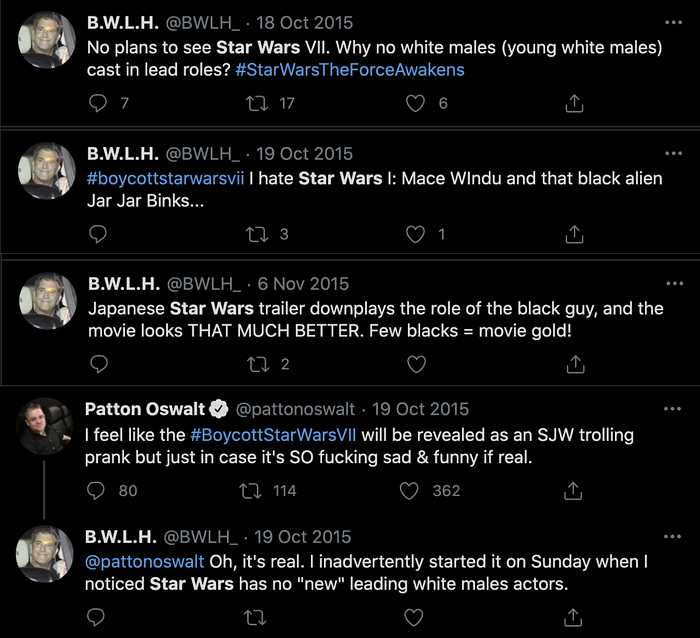
On VDARE, Thompson writes, “say what you will, getting people to think in the terms a movie is “anti-white” is a huge positive, because it allows them to consider the notion of their own dispossession — especially if they’ve never even thought of this reality before.”
On Twitter, people were considering these white supremacist ideas including user @AngryGOTFan who tweeted that weekend in support of the hashtag:
“THE #BOYCOTTSTARWARSVII PEOPLE HAVE A POINT. #PROBLEMATIC”
The text was included above a picture that insinuated that the new Star Wars film was “anti-white” because people of color were being portrayed as the good guys and white actors were playing the bad guys.
This image would also appear on the website* of white nationalist podcast and banned Youtube channel Red Ice. Similar to Thompson’s article on VDARE, the white supremacist site claimed that “#BoycottStarWarsVII has opened minds to the concept of White Genocide.” The site continues with anti-semitic conspiracies claiming that “Star Wars: The Force Awakens is being called ‘anti white propaganda’ and Twitter is ablaze with users calling J.J. Abrams a ‘Jewish activist.’ Abrams, and most of the cast of Star Wars, are Jewish. Does Star Wars propaganda connect with The Protocols of the Elders of Zion?”
The boycott would also draw the attention of Holocaust-denying publisher, Chuck Johnson, on the former site Got News* where he wrote, “is the very white Star Wars being culturally appropriated by the Jewish J. J. Abrams?…Star Wars is a productive [sic] of a white America whether or not we want to accept it. The action figures that made George Lucas a billionaire were purchased by suburban white families.”
Less than a year after supporting the racist hashtag on Twitter, @AngryGOTFan would be sitting next to neo-nazi figurehead Richard Spencer, VDARE’s founder Peter Brimelow, and Jared Taylor, founder of the white nationalist group American Renaissance, at the 2016 Republican National Convention.
Soon after, @AngryGOTFan would change his twitter name to @JackPosobiec and rise to fame as an alt-right leader pushing dangerous conspiracy theories such as pizzagate alongside Mike Cernovich. Posobiec currently serves as a host on far-right media network One America News Network.
It should also be noted that Posobiec would establish a direct connection to Thompson during the publication of No Campus for White Men: The Transformation of Higher Education into Hateful Indoctrination. No Campus for White Men is a book written by Scott Greer, a friend of Thompson’s, and former editor and columnist at The Daily Caller. The book’s forward is written by Yiannopoulos while Cernovich takes center stage on the book’s jacket. According to Right Wing Watch, Posobiec and Thompson may have also been connected through MAGA3X, a group of white nationalists who tried to manipulate social media to influence Trump’s candidacy.
Posobiec would also play an important role in the next iteration of the 21st century online culture wars: The spread of hate against Star Wars Episode VIII: The Last Jedi.
The New Gamergate: The Rise of Alt-Right Ideology in Star Wars Fandom
Star Wars Episode VIII: The Last Jedi released on December 15, 2017 to universal acclaim from critics and a glowing audience score from CinemaScore, the only statistically sound audience score available to the general public. The movie would go on to gross 1 billion dollars in less than three weeks and become one of the most successful movies of all time.
Yet, even with its obvious success, the narrative surrounding the film claimed that the movie was “one of the most polarizing Star Wars movies ever released.” This narrative was overwhelmingly driven by the film’s Rotten Tomatoes’ audience score (that currently sits at a “rotten” 42%) and calls from vocal “fans” on Twitter to fund a remake of The Last Jedi.
According to @RMTheLastJedi, the account behind the campaign to remake The Last Jedi, the film was bad because the creatives behind the film “lost their way from the hero archetype.” There isn’t much explanation on what this means beyond Kelly Marie Tran’s Rose Tico failing to live up to this fan’s expectations of being a “badass pilot.” In fact, many complaints against the film are aimed at its female characters. One fan illustrated this when he released an edit of The Last Jedi with all women removed.
Yet even as sexist motives behind the backlash were revealed and as an alt-right Facebook account claimed credit for the review bombing of The Last Jedi on Rotten Tomatoes (more on this one later), no one could escape the narrative that The Last Jedi was divisive.
From a data analyst’s perspective, there isn’t much that is divisive about an exit review poll of an “A” and a movie that grosses as much money worldwide as the much-anticipated final installment of the Harry Potter franchise. Nay-sayers will claim that the movie is a failure because it didn’t gross as much as The Force Awakens, but benchmarking a second film in a franchise whose value is partially tied to the fact that the franchise had produced no content in more than 10 years is not the best approach. However, the debate raged on.
So, for the sake of argument (once again — no metric that isn’t an internal brand tracker or segmentation within Disney will be as statistically accurate as the CinemaScore), I wanted to conduct a sentiment analysis on two major social media platforms: Twitter and YouTube. If this movie was truly polarizing, there should be a positive to negative sentiment ratio of 1:1. This means that for every positive tweet or YouTube video, there should also be a negative tweet or YouTube video.
Additionally, if The Last Jedi truly divided fans, we should see a similar mix of the types of accounts spreading positivity or negativity about the movie. In other words, tweets getting the most likes or YouTube videos receiving the most attention in the search algorithm should proportionally come from people with similar backgrounds. “Backgrounds” here is defined as affiliations people have with a certain profession, such as a journalist, or community online, such as YouTubers. We should also see both positive and negative sentiment from average fans rising to the top of the conversation.
Was The Last Jedi Polarizing?: A Twitter Analysis
To get a strong idea of sentiment on Twitter, I analyzed over 1 million tweets from December 2017 to November 2018 collected at various times between 2019 to 2020 (please see the methodology section at the bottom of this article for full details). I used two different methods to analyze sentiment: 1) the positive to negative sentiment ratio of top words by volume and 2) positive to negative sentiment ratio of top tweets (defined as any tweet with > 1,000 engagements).
Both methods allow for manual correction of what constitutes a tweet as “positive” or “negative.” This means that the analysis is not left up to simple matching of positive or negative words. The keyword matching method can be misleading because, for example, a tweet containing the word “liked” would be classified as positive when matching positive keywords in a set to positive keywords in the data. However, most tweets using the word “liked” include the text “I liked a video on YouTube.” This tweet is actually neutral and can skew the model. Furthermore, tweets that are positive can use negative keywords and vice versa.
Method 1: Top Words by Volume
A common practice in text analysis is to see which words are used the most within a sample. In this case, I was looking for words that were used more than 10,000 times. In order to accept my hypothesis that the positive to negative sentiment ratio would be 1:1, I expect to see a word like “love” used as often as a word like “hate.” However, that is not what I observed in the sample.
After removing positive keywords that could be attributed to neutral conversations such as “liked” or “like”, remaining positive keywords used for the sentiment ratio consist of the following: “love”, “favorite”, “enjoyed”, “great”, “best”, “good”, and “amazing.” Negative keywords used for the sentiment ratio include “worst”, “hate”, “shit”, and “bad.”
Most-used positive keywords make up 143,548 total tweets while most-used negative keywords make up 67,246 tweets. This is a positive to negative sentiment ratio of 2.1:1, meaning that conversation about The Last Jedi on Twitter likely leans positive.
It is important to note, however, that tweets with negative keywords are more likely to have positive connotations. Tweets with positive keywords are mostly positive, barring several tweets that could be considered good-hearted fun vs. a positive statement about the film.
For example, the two visualizations below show all tweets mentioning “The Last Jedi” with top positive keywords (Visualization A) and top negative keywords (Visualization B), respectively. The tweets have been separated into two groups: 1) Tweets that are at or above the number of average engagements per tweet and 2) Tweets that are below the number of average engagements per tweet. There are no statistically significant differences between average engagements (replies + comments + likes) per tweet for top positive vs top negative keywords. Both keyword groups have about 10 average engagements per tweet.
Tweets with negative keywords consist of a handful of tweets that have engagements significantly above total engagements of other tweets. The majority of these tweets are not negative towards The Last Jedi, but instead are mostly tweets in defense of the film that contain negative keywords.
Visualization A: Tweets mentioning “The Last Jedi” with Top Positive Keywords by Number of Total Engagements
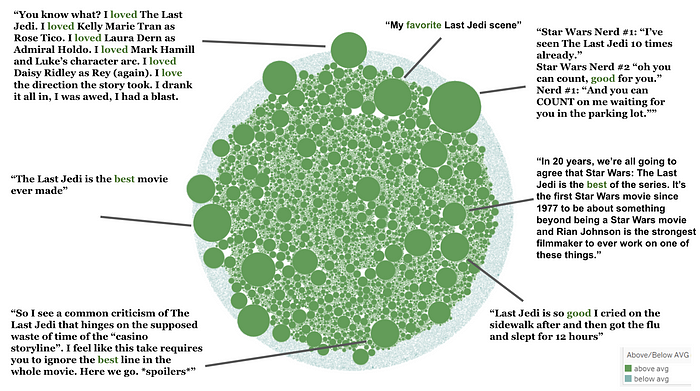
Visualization B: Tweets mentioning “The Last Jedi” with Top Negative Keywords by Number of Total Engagements
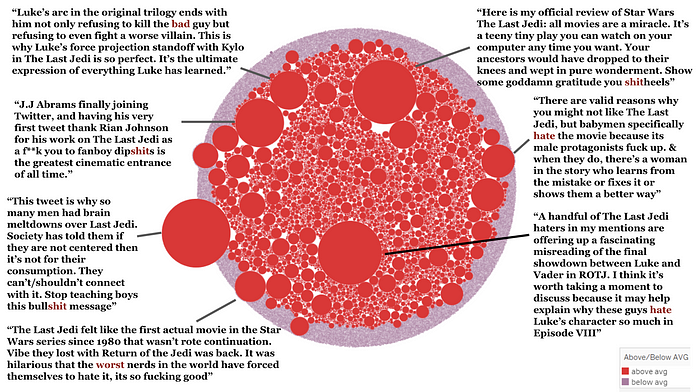
Just by deleting only 25 tweets that are considered “false negatives” above (Visualization C), average engagements per negative tweet dropped from about 10 average engagements to about 7 average engagements. This suggests that positive tweets about The Last Jedi receive more engagements on average vs negative tweets about The Last Jedi.
Visualization C: Tweets mentioning “The Last Jedi” with Top Negative Keywords by Number of Total Engagements (25 false-negatives removed)

Method 2: Top Tweets by Engagements
In this second method, I manually classified sentiment for tweets with > 1,000 engagements. In this group of 955 tweets (if that sounds like a low number to you, remember that 80% of tweets are driven by 10% of users!), I would expect tweets with the most engagement to be both positive and negative if this film is truly polarizing.
However, there are more positive tweets in the sample vs negative tweets with a positive to negative sentiment ratio of 3.4:1 (213 positive tweets vs 62 negative tweets). This means that tweets with the most engagements mentioning “The Last Jedi” are positive.
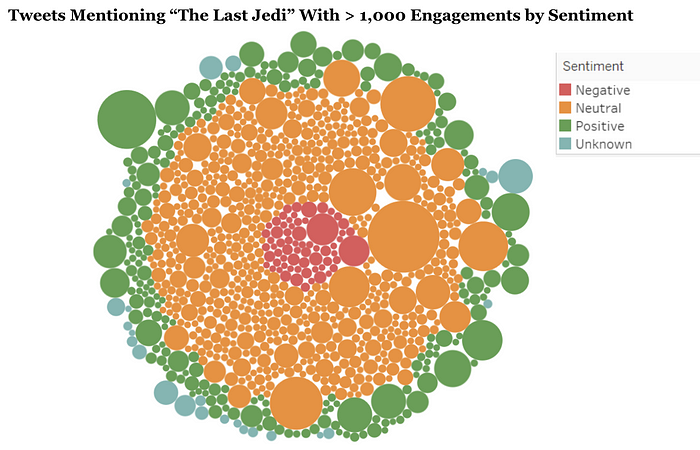
I also wanted to know who was behind these negative or positive tweets. I found that across both positive and negative groups, accounts belonging to journalists and news publications drive conversation. Almost a quarter of positive tweets and ~20% of negative tweets are tweeted by accounts associated with journalism.
Positive tweets are driven more by average fans or people who did not associate with a profession in their bio (noted in this classification as “other”) than negative tweets (23% of positive tweets are classified as “other” vs 16% of negative tweets).
Almost 40% of negative tweets are from accounts with a gaming YouTube or Twitch profile in their Twitter bio or profile vs only 10% of accounts tweeting positive things about The Last Jedi.
When combined with accounts who link back to their YouTube channel, but are not associated with gaming, almost half of all negative tweets are from accounts who direct Twitter users to a YouTube or Twitch profile vs only 15% of positive tweets. This suggests that a considerable amount of hate against The Last Jedi is generated on YouTube.


Before analyzing sentiment on YouTube, however, I wanted to see if there is a concentration of alt-right or right-wing reactionary accounts for either positive or negative tweets.
For this analysis, I decided to make alt-right and radical right-wing associated accounts their own affiliation. This means that, for example, if the account was previously associated with “journalism”, “alt-right/radical right” affiliation would take precedence and become that account’s affiliation.
This new methodology did not change the categorization for tweets that are positive about The Last Jedi. However, it did significantly change the results for tweets that are negative about the film.
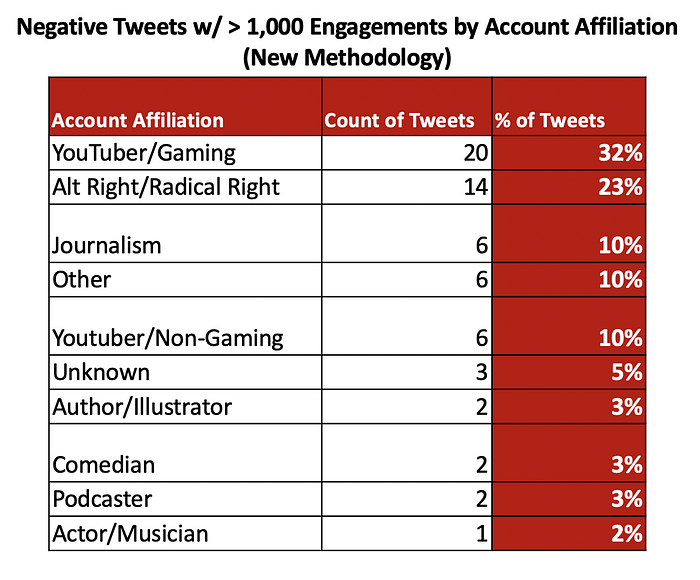
Almost a quarter of tweets spreading hate against The Last Jedi are from alt-right/radical right-wing affiliated accounts. Notably, accounts affiliated with journalists or news publications in the first methodology dropped from 19% of tweets to 10% of tweets after performing this analysis.
Tweets that are classified as “other” also dropped from 16% to 10%, indicating that a portion of “average” fans are affiliated with alt-right networks (specifically the previously mentioned account @rmthelastjedi, which is an alt-right affiliated account).
It should be noted that top engaged negative tweets against The Last Jedi also include two left-wing accounts (3% of total tweets) including Will Menaker, a co-host of socialist comedy podcast Chapo Trap House, who has been involved in sexist controversies of his own.
Negative Tweets w/ > 1000 Engagements by Account Affiliation

Positive Tweets w/ > 1000 Engagements by Account Affiliation
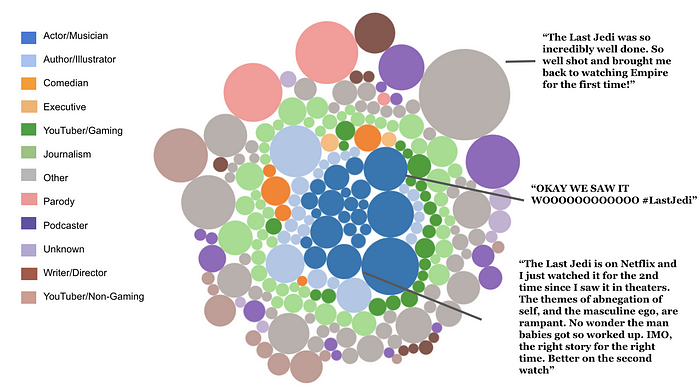
Aside from the Twitter account seeking to remake The Last Jedi, alt-right or radical right accounts also include Rubin Report host Dave Rubin, whose show has platformed racist alt-right guests, and Ben Shapiro.
Shapiro, who has been particularly vocal against The Last Jedi, is the former editor-at-large of Breitbart from 2012 to 2016 during the publication’s spread of white supremacist and anti-feminist views into the mainstream, and is the current host of right-wing talk show The Daily Wire.
Shapiro is known for denying human rights abuses, including his claim that members of the LGBTQ+ community do not face discrimination. He also believes that homosexuality and identifying as transgender is a mental illness.

Other examples include hate against Rose Tico pushed by an avidly pro-Trump Twitter account and a writer for The Babylon Bee, a Conservative satirical site that has used the cover of satire to joke about the Capitol insurrection and make snide remarks against Black Lives Matter protests.
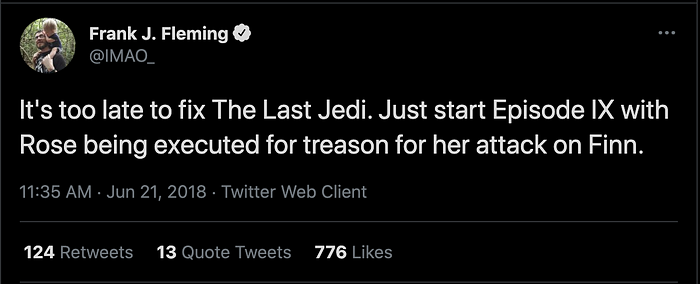
All Roads Lead to YouTube: An Analysis
As established in the last section, I know that almost half of the negativity about The Last Jedi from top-engaged tweets are from an account that links back to a YouTube or Twitch page. Therefore, going into this analysis, I was expecting YouTube to be more negative against The Last Jedi than what I observed on Twitter.
YouTube videos containing the keyword “The Last Jedi” were analyzed based on the videos provided to me in the algorithm. In other words, I was only analyzing videos that YouTube would give me if I was looking to watch a video after searching “The Last Jedi” in the YouTube search bar.
As I expected, sentiment on YouTube leans slightly negative with a negative to positive sentiment ratio of 1.6:1 (48 negative videos vs 30 positive videos out of 447 total videos).
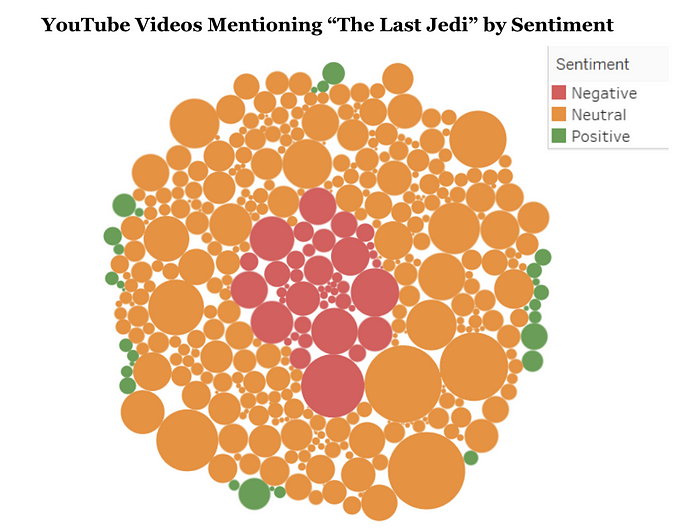
Like the analysis I conducted on Twitter, I wanted to dig into who these videos belonged to. I simplified the methodology for this analysis and looked at three affiliations: 1) YouTubers who make videos about games/gaming, 2) YouTubers who use their channel to push alt-right or radical right ideology or 3) accounts that do not meet the first two affiliations including media YouTubers, culture critics, or fandom personalities.
The vast majority of positive videos (about 87%) about The Last Jedi are fair reviews by accounts that would be included in the third category including media YouTubers like Chris Stuckmann and WhatCulture, fandom personalities like Kevin Smith, and podcasters like Mr. Sunday Movies. The remaining 13% of positive videos are from users who make YouTube videos about gaming.
Negative YouTube Videos Mentioning “The Last Jedi” by Account Affiliation
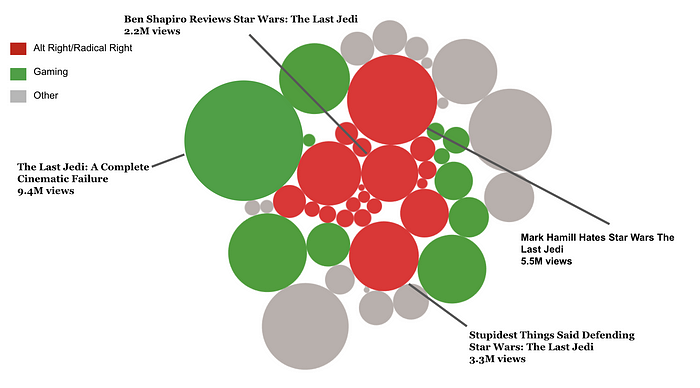
Positive YouTube Videos Mentioning “The Last Jedi” by Account Affiliation
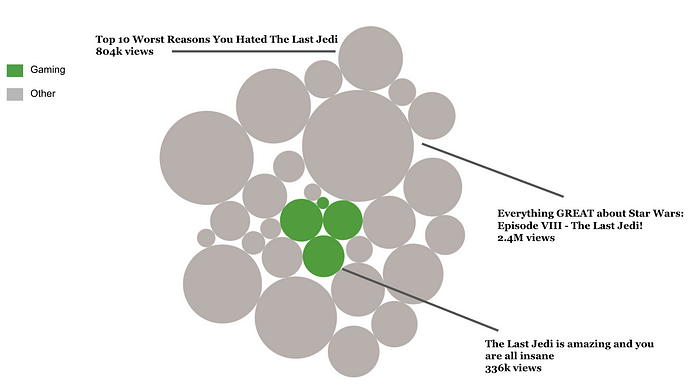
In comparison, 40% of negative videos are classified as “other” and include negative reviews by RedLetterMedia and Wisecrack. It should be noted that “other” also includes videos by WhatCulture. Although WhatCulture’s review of The Last Jedi is ultimately positive, the YouTube channel did release 2 negative videos about the film, seemingly cashing in on the YouTube backlash.
A quarter of negative videos are from channels that post content about gaming. However, within this group, several accounts could be labeled as pushing alt-right or radical right wing ideology, but are not classified as such since their channels do not primarily push a political agenda or their exact political beliefs are hard to pin down.
For example, PewDiePie, whose opinion on The Last Jedi is negative overall, hasn’t been without racist and anti-semitic controversies. In 2017, PewDiePie was called out for use of Nazi imagery in his videos, including a sign that read “Death to All Jews.” Later that year, he used the n-word to describe a player during a stream of Playerunknown’s Battlegrounds.
Another example is YouTuber Vito whose negative review of The Last Jedi entitled “The Last Jedi: A Complete Cinematic Failure,” is one of the most viewed videos mentioning the film with 9.4M views.
His political views vary from right-wing to leftist and he doesn’t like to associate with alt-right leaders like Jack Posobiec, who he has described as a “grifter” (even though he does indeed follow Posobiec).
However, in Vito’s review, the YouTuber states that one of the flaws of The Last Jedi is that Rian Johnson uses Laura Dern’s character Vice Admiral Holdo to compel the audience to “trust women.” To make this point, Vito invokes criticism against the #metoo movement to suggest that asking the audience to trust female characters in power is the same as asking people to trust women who come forward with their stories of sexual assault. He states in the video:
“What is the moral between the flawed interactions between Holdo and Poe? The most obvious moral is to be subservient to authority and blindly trust your superiors…however, the real moral is the ultimate exercise in jamming politically correct politics into a kids movie with all the subtle nuance of a bad guy literally named General Grievous.
See, Poe thinks he’s a better leader than Holdo because he’s a man. So, he starts mansplaining…but what he really should have done is ‘#trustwomen.’ No matter what the situation, even if it seems like that particular woman is about to get you and everyone you love incinerated by a million lasers, just trust women. She knows what’s best. She is living her truth. #metoo. #timesup.”
Vito has also spread racism on his Twitter account. In a quote tweet of an article reporting that a podcast host had been suspended for using racial slurs, Vito insists that “I rap along to songs containing the n-word and I have never once felt bad about it.” He then proceeds to tweet the racial slur.
Another 37.50% of negative videos are attributed to accounts whose channels actively push alt-right or right-wing misogynistic or racist ideology including a video by Bishop Robert Barron, who has been a guest on Dave Rubin’s Rubin Report. In his video, he asserts that The Last Jedi is a bad film because Rey’s characterization “occludes” the male hero, Luke Skywalker.
Ben Shapiro also has a negative review of the film on his YouTube channel for The Daily Wire where one of his critiques against The Last Jedi is that Johnson’s filmmaking is “nasty to [his] childhood.” This “criticism” is embedded in Shapiro’s central ideology that American society is moving further away from the Judeo-Christian values that shaped “The West” and any departure from those values will only make America a weak state.
His other criticisms — like the majority of criticism leveled against The Last Jedi on YouTube — are misogynistic and claim that the film would be better if Rey was not the “ultimate Mary Sue.”
Mary Sue is a pejorative label given to female characters who typically have a lead role, are strong-willed, powerful, and are allowed to exercise femininity. The term applies standards towards female fictional characters that are not applied to male characters in an effort to dismiss their legitimacy in the narrative.
Other examples of right-wing hate about The Last Jedi on YouTube includes a YouTube channel called IDRLabs. This channel pushes anti-feminist hate and general negativity about The Last Jedi and The Force Awakens, along with videos on anti-Marxist conspiracies and short videos against socialism. All of these videos lead to IDRLabs’ website, which contains hundreds of personality tests.
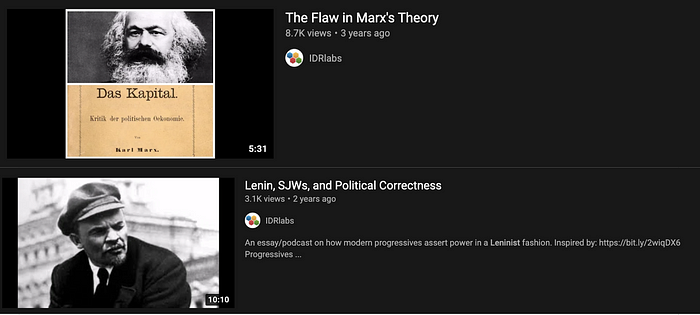


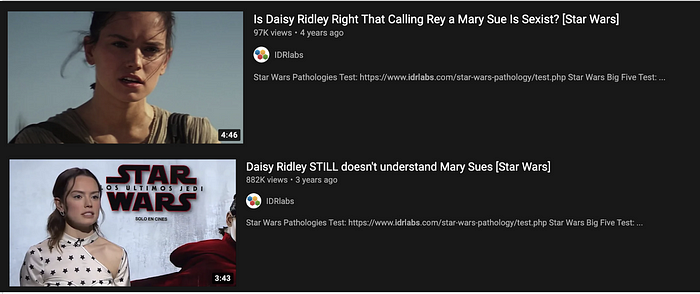
Looking through the personality tests on their website, it reminded me of a comment by Christopher Wylie. When asked how Cambridge Analytica created a tool for cultural and political change through data science, he explained that “before you can use Facebook likes to predict a person’s psychological profile, you need to get a few hundred thousand people to do a 120-question personality quiz.” These questions were used to build up profiles on users who they could target. The information from these users was also used to train and strengthen machine learning algorithms that would identify similar individuals to that targeted user. In 2019, Facebook banned the use of personality tests for this reason.
IDRlabs’ website contains a range of personality tests mostly focusing on political alignment, feminism, racism, pop culture, and Meyers Briggs personality types that are 20–50 questions each. One asks to test how fascist you are.
The tests claim to be created by professionals, however, no psychological professionals are listed on the site. Reddit user Vleglo pointed out in a 2018 Reddit post that the site contains no methodology. Additionally, the user notes that the site is “quite popular on Facebook.”
I don’t have enough information to conclude whether or not anti-feminist opinions about Star Wars and negative The Last Jedi sentiment were used to push people to personality tests that built machine learning algorithms for Cambridge Analytica. However, I will say it is interesting that IDRLabs’ YouTube channel posted a video entitled “Cambridge Analytica Scare!” where they call the accounts of whistleblowers such as Wylie “overblown and far too convenient.”
Aside from conservative talk show hosts and strange personality profilers, the majority of right-wing YouTubers spreading anti-The Last Jedi hate are from a slew of alt-right associated YouTubers who have dubbed themselves “The Fandom Menace.”
The Star Wars Alt-Right Recruitment Problem
The center of alt-right and radical right-wing ideology in Star Wars fandom is on YouTube, a favorable (and profitable) home for indignation against non-white and non-cis male individuals built up on 4chan during Gamergate. It isn’t difficult to find videos of mostly white men belaboring their strongly held belief that women and minorities are ruining video games, comic books, and Star Wars. They reiterate these convictions as they wade through tweets, articles, and blog posts that they associate with the mainstream ‘left” in an effort to create alternative news sources for their followers.
It would be unfair to say that these YouTubers are the exact same group of people who rallied behind anti-feminist figureheads like Cernovich and Yiannopoulos to harass women in gaming (even if they* still* are.*). The reality is far more terrifying.
The majority of these YouTubers — who include reactionary alt-right YouTuber The Quartering and ComicArtistPro Secrets, a leader of Gamergate successor Comicsgate — are people who have been radicalized by what Gamergate set into motion. Whether they realize it or not, they are diligently carrying forward Steve Bannon’s master plan to change culture in order to change politics. And there is no better target for such an agenda than a franchise considered to be a cultural touchpoint of modern Western myth.
The shared narrative across this group’s thousands of videos is simple: First, Kathleen Kennedy ruined Star Wars by allowing women to work in too many creative jobs at Lucasfilm. Then, Rian Johnson ruined Star Wars by emasculating Luke Skywalker, creating the character of Rose Tico, and letting Rey win a lightsaber fight before going through an extensive training montage. And before all of that, Disney ruined Star Wars by hiring both Kathleen Kennedy and Rian Johnson.
For anybody not radicalized enough to believe this narrative, these types of videos with outrageous headlines written in all caps and memes do look, well, silly. It’s simple to look at these people, have a laugh, and walk away. But we do unfortunately have to pay attention to what these angry (mostly) white men in front of a web camera have to say because, as this article has pointed out, the systems of power leveraging this kind of enmity online are organized, ruthless and tied back to some of the most hateful people in the United States.
Due to this, there are three very important things we need to be aware of when discussing reactionary right-wing fandom spaces:
- They are, indeed, nothing but a replication and continuation of Gamergate
- They can be highly profitable
- They play a considerable role in alt-right radicalization
The Replication and Continuation of Gamergate
Just in case you haven’t put the pieces together by now — no, it’s not a coincidence that the top affiliation for negative comments against The Last Jedi on Twitter lead you right back to gaming spaces on YouTube. And, no, it’s not a coincidence that people in gaming spaces who don’t actively push alt-right agendas still spread racist, anti-semitic, and misogynistic ideology. And finally, it is absolutely not a coincidence that out of 13 unique accounts classified as alt-right or radical right who appear in the algorithm after searching “The Last Jedi”, 53% also make videos on gaming.
“Gamers” are a pretty significant segment of the general American population and by no means is the very online culture surrounding video games representative of all people who consider themselves “gamers.” Furthermore, online gaming communities are not a monolith. Communities around games like the Kingdom Hearts or Final Fantasy franchises work very differently than communities surrounding the Call of Duty franchise, for example. But even though most people who consider themselves gamers don’t actively spread hate, the events of Gamergate have given the online gaming space an undeniable toxic culture problem that has only gotten worse.
Now, it would be irresponsible of me not to point out that videos about gaming are generally popular on YouTube and are one of their top content categories. So, to better illustrate how Gamergate has never really died, I took the titles of all videos from 20 Star Wars and/or pop culture YouTubers who were 1) negative against The Last Jedi and 2) had the most viewed anti The Last Jedi videos or 3) had the largest volume of videos for a certain topic associated with The Last Jedi such as the search terms “Rian Johnson” or “Rose Tico.”
All accounts are associated with alt-right YouTube networks, spread alt-right ideology, and/or have videos defending people in alt-right spaces. The following wordcloud shows the top most used words seen at least 130 times across 20,366 YouTube titles.
In the titles of these videos, top words include words associated with gaming spaces such as “gamers”, “games”, and “Twitch”. More importantly, top used words consist of phrases and buzzwords associated with Gamergate and alt-right ideology including “woke”, “media”, “Comicsgate”, and “SJW.” “SJW” stands for “social justice warrior,” a phrase made common in alt-right and reactionary communities by Yiannopoulos during Gamergate. A “social justice warrior” is a catch-all term for any person who advocates for diversity in media.
Also appearing in the wordcloud is the word “Ghostbusters,” the 2016 all-female reboot of the 1984 film of the same name. This film was targeted by members* of the alt-right including Yiannopoulos in yet another attempt to push anti-feminist sentiment into mainstream culture.
The alt-right hate towards Ghostbusters infamously targeted Leslie Jones with racist harassment on Twitter and leaked nude images from the Ghostbuster star’s hacked iCloud account. This harassment eventually led to Yiannopoulos’ permanent ban from the social media site.
Other political keywords include the word “Trump,” where anti-The Last Jedi YouTubers criticize anti-Trump media or actors including Marvel actor Don Cheadle, Star Wars actress Daisy Ridley, and Leslie Jones.


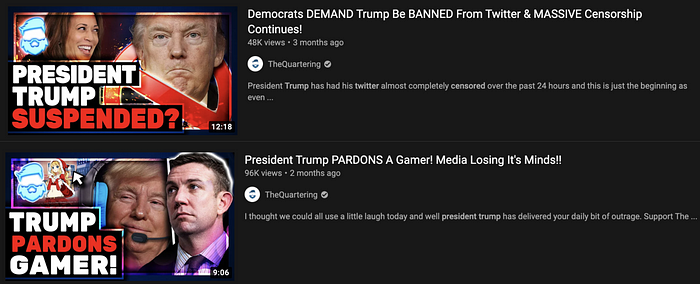



The keyword “white” is also a top word used in these video titles. The videos containing the word mostly express outrage at media that is “racist” towards white men. The videos invoke ideology and rhetoric from white nationalist groups, specifically that mainstream liberal media has an agenda to push white men from society in place of non-white people.



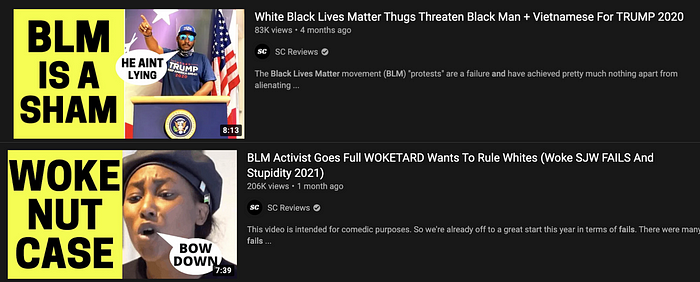

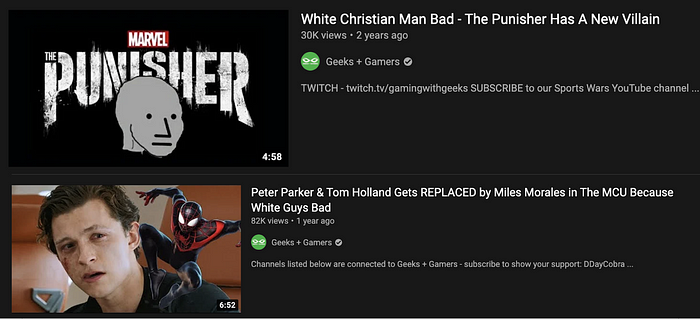

“Female” is also a top word used in these YouTube titles. These videos spread anti-feminist ideology similar to hate spread against Sarkeesian and Quinn during Gamergate. Videos express outrage over Hollywood hiring women to direct major blockbuster films and female characters given more prominent roles in pop-culture franchises including Marvel and Star Wars.
YouTuber Nerdrotic even suggests that Thor: Love and Thunder director, Taika Waititi, “wants to destroy Marvel mythos” by including a “female Thor” — the all-too-common narrative across alt-right spaces that suggests that women and minorities are destroying culture.
Anti-feminist ire is also directed towards the star of Captain Marvel, Brie Larson, who became a target of the alt-right when she spoke out against the lack of diversity in the film industry.

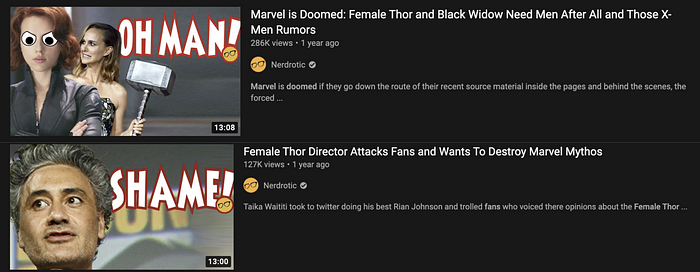


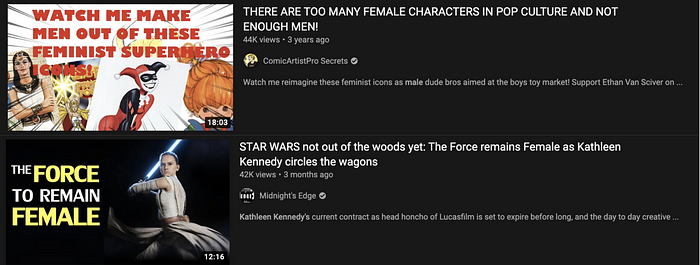

Furthermore, a considerable amount of hate is focused on Kathleen Kennedy, the President of Lucasfilm, who the alt-right blames for making Star Wars too focused on diversity, inclusion, and feminism.
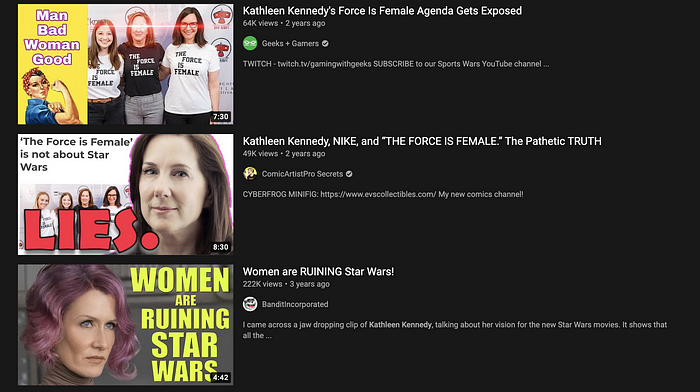

In fact, 73% of top YouTubers by count of the number of videos they have made mentioning “Kathleen Kennedy” are from alt-right associated accounts including 40 videos made about Kennedy alone by alt-right YouTuber Geeks + Gamers.
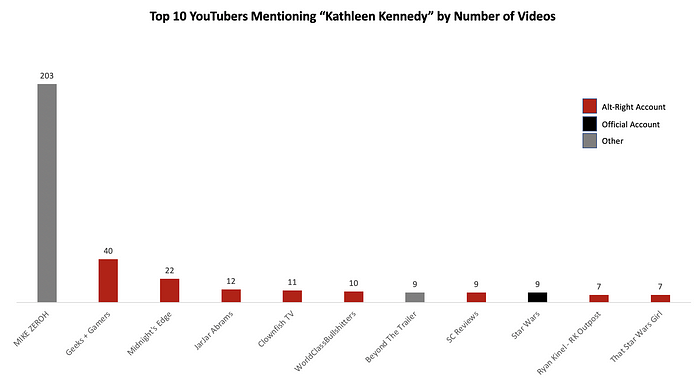
What these YouTube videos definitively show is that Gamergate’s playbook is very much alive and has been made accessible to anybody with a webcam. This not only increases visibility of harmful attacks against women and people of color, but also creates a way for people to profit from hate.
The Profitability of Hate
Like most figures in the alt right or reactionary right-wing space, the grift is never far behind, whether it be through merchandise, membership clubs, or book sales. It’s relatively easy to make money off of YouTube videos. On average, YouTube pays $3 to $5 per 1,000 video streams, but it should be noted that the amount of money a YouTuber makes can vary widely.
Using this range, I can estimate the amount of money the 20 anti-The Last Jedi YouTubers from above have made in the lifetime of their channel. This does not include any money made from merchandise sales or Patreon subscriptions, which tend to be more lucrative than what the average person can make off of YouTube ad revenue.
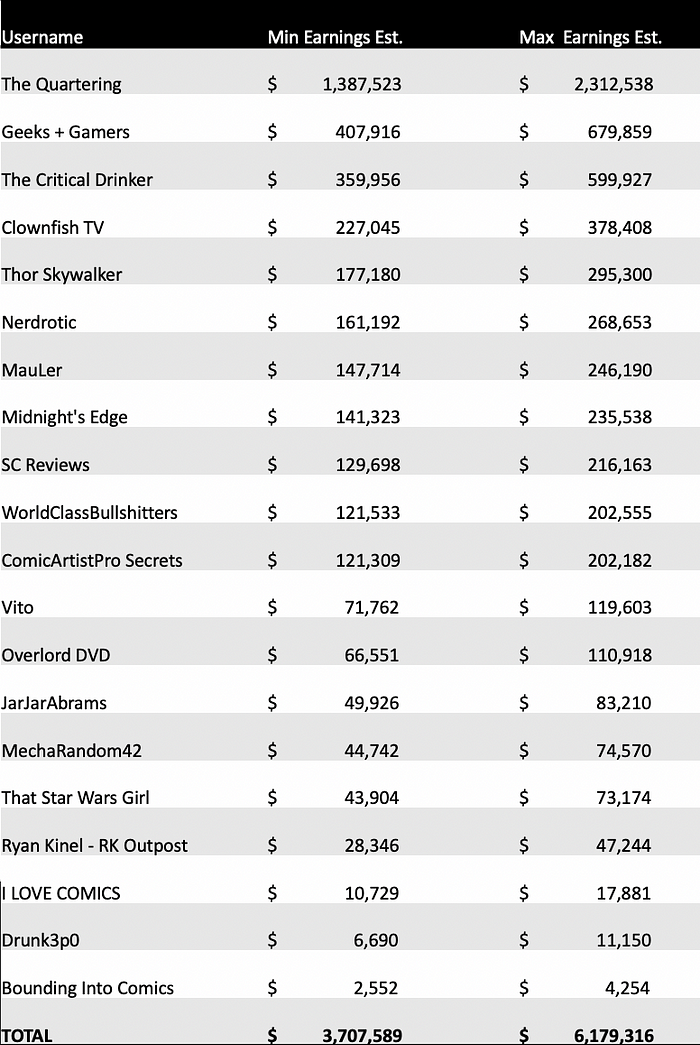
Keeping in mind that the majority of channels have been active for only 3–4 years, the current avg max total earnings within this group is $308,966 with a median of $202,369. The likely top earner within this group is The Quartering who potentially has made over $2M from his channel.
Geeks + Gamers, a YouTuber who commonly decries Lucasfilm for their “feminist agenda*” and “[problems] with white people*”, has potentially made as much as $680K pushing pro-Trump sentiment*, anti-feminist propaganda*, and white supremacist ideology*.
Obviously, the more a channel rakes in in ad revenue, the more popular that channel is. And the more popular that channel is, the more visibility the channel has on YouTube. This creates an easy pipeline for alt right radicalization.
The Role of Radicalization
Americans in particular typically describe “radicalization” as some covert operation that happens discreetly in a remote part of the Middle East. However, this narrative is dangerously misleading (and typically racist). Radicalization into extremist political views can happen anywhere and to anyone. And it can be as easy as watching a few YouTube videos.
The Social Dilemma, a documentary by the Center for Humane Technology, provides an example of alt-right radicalization wherein a young man becomes imbued with right-wing extremist ideology after being subjected to YouTube’s algorithm.
In the documentary, Guillaume Chaslot, a former YouTube engineer, explains that:
“It worries me that an algorithm that I worked on is actually increasing polarization in society, but from the point of view of watch time, this polarization is extremely efficient at keeping people online.
People think that the algorithm is designed to give them what they really want, only it’s not. The algorithm is actually trying to find a few rabbit holes that are very powerful, try to find which rabbit hole is the closest to your interest.
And if you start watching one of those videos, then it will recommend it over and over again.”
In other words: YouTube is designed to keep the viewer invested in extremist hate once they get started.
It becomes clear that society is currently dealing with a perfect storm of highly effective technology building quicker than the average person can keep up with and organized political hate campaigns. These campaigns have been designed to exploit existing bigotry within society and the lack of education most people still have about the online spaces they spend so much time in. The result is a fast-acting radicalization pipeline that occurs without people noticing.
This is how the pipeline works:
First, alt-right individuals who have already been radicalized from past organized hate movements such as Gamergate or Comicsgate establish a platform on YouTube. They sit in spaces with a highly accessible on-ramp like pop culture film franchises or video games. They then gain a following by emotionally appealing to their tens of thousands (sometimes hundreds of thousands) of viewers that they are being oppressed by a culture and society who wants to see them fail. They ignite fear that viewers are losing their culture* to an “other.” Some YouTubers, including The Quartering, explicitly refer to this* as “the battle for culture.”

Once viewers are locked into these networks, there are multiple rabbit holes that the viewer can be led down that can lead to increasingly extremist misogynistic, racist and fascist views.
For example, watching any Geeks + Gamers video on how white men are being shut out of Hollywood or how women are ruining pop-culture can easily lead viewers to following the personal account of the Geeks + Gamer channel, DDayCobra.*
DDayCobra’s channel is littered with radical right-wing videos that express support for Donald Trump’s presidency and Trump’s support of the Capitol insurrection. He also uses this channel to advance fascist ideology with videos titled “The Media is the Enemy of the People.*”

Seeking out videos pushing hate against Kelly Marie Tran’s character in The Last Jedi will lead you to a video* by YouTuber Timcast where the YouTuber argues that online backlash against the removal of Rose Tico from The Rise of Skywalker merchandise is a form of “moral authoritarianism” likened back to the puritans fleeing England to establish religious freedom.
Timcast is not an alt-right Star Wars or pop culture channel. It is the YouTube channel of journalist Tim Pool who has ties* directly to Paul Joseph Watson, the editor of right-wing extremist conspiracy theory site Infowars who was banned from Facebook for hate speech. Infowars is responsible for pushing damaging conspiracy theories that led to the election of Donald Trump, including coordinating with designated hate group the Oath Keepers to organize the Capitol insurrection.

In another example of how easy it is to be radicalized in spaces leading hateful sentiment against The Last Jedi, videos from ComicArtistPro Secrets often have plugs for 12 Rules For Life by Jordan Peterson. Peterson, who has been called a “custodian of the patriarchy” by The New York Times and “the culture war’s Weapon X” by The Guardian, is a psychology professor from the University of Toronto. He is perhaps best known for claiming that progressive politics including transgender rights and the #metoo movement will lead society to Stalinism.
Peterson is especially dangerous because he disguises highly subjective and damaging transphobic, homophobic, racist, and misogynistic ideology as “self-help” and “reason” for young men. While he claims not to associate with alt-right groups, he has many fans in those spaces including Gavin McInnes, founder of far-right militia group the Proud Boys.

There are more paths to this designated hate group than through Peterson. Many anti-The Last Jedi YouTubers cite a blog called “Disney Star Wars is Dumb.” The blog is run by an unknown person under the pseudonym “ItchyBacca,” who, among publishing a slew of white supremacist articles on their blog, publicly supported the Proud Boys on their twitter account during the Capitol insurrection.
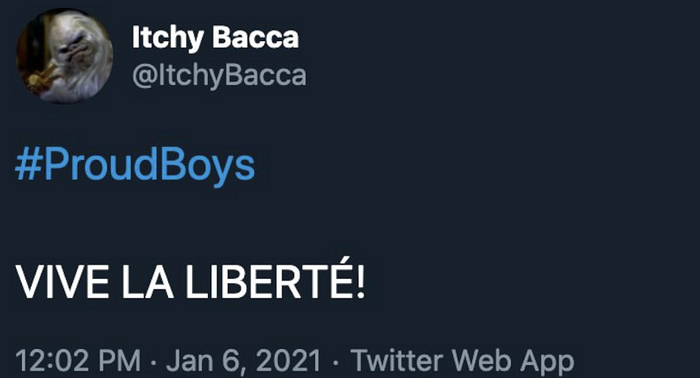
ItchyBacca’s site is a particularly dangerous rabbit hole because it gets to the heart of what hate against The Last Jedi, in particular, is really about: the battle to preserve “white” culture.
In one article, ItchyBacca lays out a step-by-step “guide” (written in conjunction with ComicArtistPro Secrets and YouTubers World Class Bullshitters) about the “Phases of Geeker Gate.*” In the guide, Itchy discusses how to “effectively push back the SJW hordes” when media such as Star Wars, Star Trek, and Lord of the Rings begin to push established IP in a more diverse direction.
In the article, the alt-right is referred to as the “customer base,” while anybody who vocally praises representation in media is an “SJW.” The guide is laden with conspiracy theories including that when an IP “fails” because it did not appease the “customers,” a “false flag” event is created. According to Itchy, this false flag brings in a woman or member of the LGBTQ+ community to act as if they have been harassed. According to the Star Wars alt-right YouTubers and bloggers, examples of this include the racist harassment against Kelly Marie Tran and Leslie Jones, which they claim never happened.*
The guide concludes that the push for representation in media is a conspiracy that is meant to destroy franchises. Once a franchise has failed because it did not listen to the “customers” and keep the franchise away from the influence of women, LGBTQ+, and people of color, the “SJWs” move onto the next franchise and repeat the process until every IP has been bled dry.
This “process”, Itchy asserts, is all part of the “cultural civil war.”
The article then goes on to list “countermeasures” including contacting shareholders, contacting merchandise management, boycotting and starting boycotts, encouraging inside leaking of information about the IP, pitting creatives and celebrities against each other and against fans, and monetizing hate.
The blog also has articles comparing Lucasfilm’s alleged “hatred of straight white Christian males*” to propaganda tactics used by the USSR. Additionally, the blog has an assembled timeline* of over 90 articles claiming to catalog all instances in which Lucasfilm was “hateful” towards “white males,” including articles that aided in the harassment of women of color employees at Lucasfilm, Justina Ireland and Krystina Arielle.
The hate found within this blog and its mission to protect culture for the true “customers” of the IP echos the thoughts of Michael Thompson (“Paul Kersey”) within the pages of VDARE.
Shortly after the release of The Last Jedi, Thompson continued to push racist hate against the Star Wars sequel trilogy. In an article* entitled “The Last Jedi: Are Whites Getting The Message That Disney Doesn’t Want Them?” Thompson writes:
“The Left dominates the culture, but it does not (yet) completely control it — hence, for example, the War On Christmas Resistance, Gamergate, and of course the election of Donald J. Trump. Now Star Wars Episode VIII (The Last Jedi), released in mid-December to resounding applause from Main Stream Media reviewers is tanking, well behind the 2015 Star Wars movie The Force Awakens. It may not be a border wall, but it’s something.”
Thompson here implies that The Last Jedi not making as much money as The Force Awakens is proof of the successful backlash against the film, which he establishes as “whites” keeping “white” culture safe from the invasion of “the Left.”
Thompson continues:
“as the cultural war changed to being overtly anti-white, so the good guys of Star Wars became more diverse and non-white.
Indeed, the multicultural, diverse band of seemingly Social Justice Space Warriors (a pink haired Laura Dern assuming control of the Resistance forces is perhaps a gratuitous embodiment of the Left in 2017) occupying a galaxy far, far away was clearly a primary selling point to MSM reviewers…
One of the last to understand the new racial hierarchy is Luke Skywalker himself, the actor Mark Hamill. He has very publicly denounced the new direction , saying “I fundamentally disagree with virtually everything you’ve decided about my character.” Obviously, Hamill does not understand that the blond, blued-eyed Jedi Knight he portrayed on film is…unacceptable in our more tolerant, SJW-approved world….
The fact that Americans seem to be… tuning out and rejecting this message is cause for hope.”
In other words, as diversity moves into pinnacles of Western culture like Star Wars, white supremacists like Thompson believe that its intention is to destroy the “dominance” in culture held by white people. Diversity in media establishes what Thompson refers to as the “new racial hierarchy.” The hate pushed against the film is a way of reclaiming and maintaining the “traditional” racial hierarchy. Thompson identifies anybody who believes in maintaining “white” culture as “Americans,” much like ItchyBacca calls alt-right fans crusading against the supposed hatred of the white Christian male “customers.”
This is why we must take these people seriously. Underneath almost every angry YouTuber who could be dismissed as a troll or a disgruntled nerd, there is a powerful system of hate and oppression that resides at the core of the most racist institutions in the United States.
The hate against The Last Jedi is yet another way vitriolic backlash against “non-white culture” was pushed into the mainstream and allowed to radicalize teens and young men and women on one of the biggest social media platforms on the internet.
And this hate was unknowingly allowed to spread until it was accepted as the truth.
How Far Right Hate Turns Into Fact
So, how did a small, concentrated group on YouTube become representative of the entire population of people who ever saw The Last Jedi?
There are several ways this happened and they include 1) an alarming media culture that puts profits over facts; 2) the use of socks, bots, and super users; 3) hashtags and boycotts; and 4) a lack of education about how to navigate online spaces, especially those under political attack.
The Danger of “Click Bait” Headlines
Pop-culture entertainment journalism, in particular, is rife with sensationalist headlines that have nothing to do with what the audience actually thought about a particular group of media. The most infamous culprits of this are pop culture sites like ScreenRant and ComicBookResources, both owned by ValNet, a company that doesn’t produce journalistic integrity, but instead produces clicks.
Respectable outlets for pop culture journalism are seemingly changing their strategies to keep up with the damage companies like ValNet have done to the industry. For example, coverage on the season finale of WandaVision from The Washington Post and The Hollywood Reporter gave time to the disappointment from very online pockets of fans who were upset their theories were not included in the finale. The Hollywood Reporter’s review claims that the episode “divided fans,” which implies that a finale currently sitting at an 8.6 rating on IMDB was somehow polarizing.
The reality is these “fans” are just a few thousand entitled nerds (and in the case of WandaVision, these are mostly just entitled nerds) who do not represent the fan population of a multi-billion dollar franchise.
The same tactic happened to The Last Jedi where coverage fervently claimed that the film was “unexpectedly polarizing,” “hated”, and “divisive.” While the articles themselves are typically quick to point out that the backlash is from a “minority” of fans, the majority of people only read headlines.
Socks, Bots, and Super Users
In October, 2018, several publications reported that 50% of hate against The Last Jedi was the result of “Russian trolls.”
These headlines were misleading. Trolls and bots have played a part in hate against The Last Jedi likely as much as trolls and bots play a role in anything making rounds in the Twitter-verse. It is true, however, that bots did have an impact on hate spread to individuals involved with The Last Jedi including director Rian Johnson.
Morten Bay, a research fellow at the University of Southern California (USC), analyzed replies to tweets made by Johnson. Bay concluded that 50% of negative tweets towards Johnson were bots, trolls or sock puppets that were likely used for political purposes.
While bots and socks can play a part in political attacks, it is important to realize that the hate is mostly homegrown and is carried out by real, hateful individuals.
In a study by University of Rochester professor, Bethany Lacina, an analysis of tweets from Star Wars fans concluded that conversation about Star Wars fans on twitter was increasingly abusive and harmful when talking about marginalized groups. She concludes that this hate mostly came from real people and not from bots.
Dan Murrell of popular YouTube channel Honest Trailer noted on Twitter that he’s “never seen a response” like the response he got on their “Honest Trailer” for The Last Jedi. He mentions that over 1,500 comments were flagged for being “aggressive or abusive.” These comments were likely real people.
Hashtags and “Boycotts”
Another popular method for how hate is made to look bigger than it actually is is the use of hashtags and “boycotts.” These tags are usually pushed by a small, but dedicated group of users.
For example, a hashtag going around Twitter after the release of the The Last Jedi was the tag “#LastJediAwful.” It was used to express negative opinions about the film. The tag is featured in one of the top tweets mentioning “The Last Jedi” between December 2017 and November 2018.
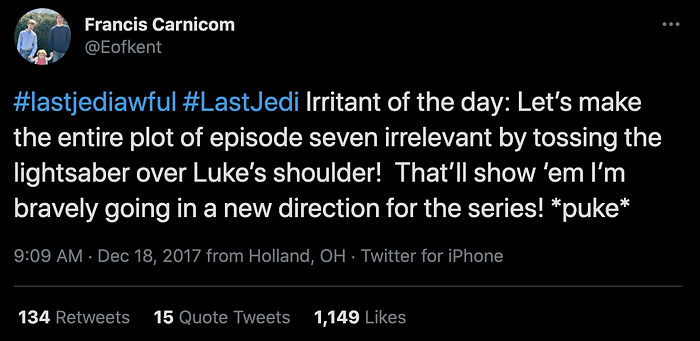
However, the tag itself was not popular. As of February 2021, there are only 6,435 mentions of the #lastjediawful tag by only 736 accounts. 84% of the top 25 accounts by most tweets tweeted with the hashtag are associated with the alt-right. All top users tweeted the hashtag over 50 times. User vexer4000 tweeted the hashtag over 900 times.
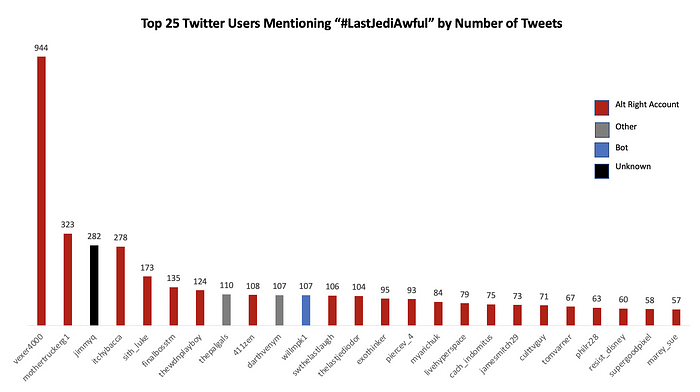
Another hashtag pushed by this group was a hashtag created in 2018 calling for “fans” to boycott Solo: A Star Wars Story primarily because of Disney’s failure with The Last Jedi. Like #LastJediAwful, the tag is only mentioned 4,713 times by 896 accounts. 72% of the top 25 users tweeting the hashtag by number of tweets are from alt-right accounts. The top user tweeting the hashtag is ItchyBacca, who tweeted the tag 612 times (vs the 278 times the blogger tweeted the #LastJediAwful tag). “Boycotts” are featured on Itchy’s list of “countermeasures” to combat the spread of diversity in media.
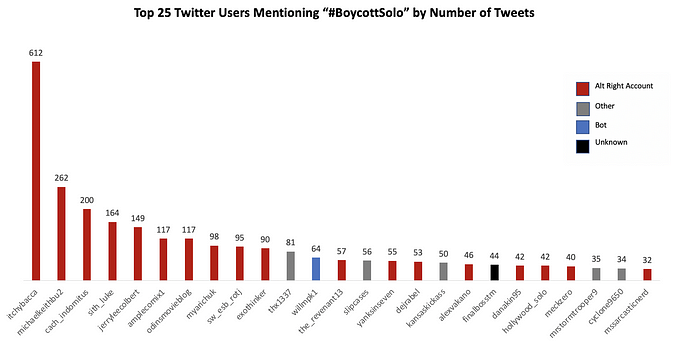
It can be argued that small but concentrated hashtags like these have been successful. While hashtag campaigns have no real impact on the box office, they can impact the narrative. Esquire points out in a 2018 article that after the release of Solo, “Disney completely re-focused its future plans. While it would be a stretch to imagine that trolls directly affected the direction of a multi-billion dollar franchise, there’s no denying that the executives at Disney have taken note of this narrative.”
Solo is the only Star Wars movie considered to be a flop. It released in theaters several weeks after the highly successful Avengers event Infinity War, which can impact enthusiasm for a movie that is highly likely to have considerable audience overlap. Disney’s former CEO Bob Iger has stated that Solo’s performance was due to releasing the film too quickly.
Another problem with the Han Solo origin film is it didn’t quite know who it was for. The crowd clamoring for nostalgia and a taste of 1977 missed important factors like Harrison Ford playing the iconic character. And an origin story about a character who was in his prime in the 70s and 80s wasn’t necessarily appealing to new fans who had been brought in by the sequel trilogy.
However, instead of reflecting on how to balance the value of nostalgia with the need to branch out into new and growing movie-going demographics, it appeared that Solo’s box office was being blamed on hate against The Last Jedi.
Shortly after the release of the film, headlines began to ask “is Last Jedi the reason fans are skipping Solo?” These articles reported on Ron Howard’s twitter activity where he retweeted and interacted with several tweets suggesting that the bad result of Solo was due to hate of The Last Jedi. This narrative was likely impacted by twitter users seeing the “Boycott Solo” hashtag campaign.
The idea that Disney’s bottom line was now being severely impacted by Last Jedi hate was also spread by influential reactionary right-wing and alt-right accounts.
In the top tweets mentioning The Last Jedi in 2018, a few tweets are about Solo’s box office result. DDayCobra on his since suspended account tweeted:
“Why Solo failed
1. The Last Jedi
2. Lucasfilm’s blind denial of TLJ backlash
3. Lucasfilm’s attack on the fans.
4. Rian Johnson is an asshole
5. Kathleen Kennedy
6. Identity Politics
Nobody wanting this film was a reason, but it’s the least relevant reason.”
Ben Shapiro also passed similar sentiment around Twitter, claiming that “the biggest problem with “Solo” is that Disney blew it so badly with TFA and Last Jedi.”
It is difficult to say for sure if any executives at Disney or Lucasfilm believed that Solo’s poor box office was due to alleged backlash of The Last Jedi, but it did become a narrative online, regardless.
Lack of Education About the Dangers of Online Conversation
The biggest reason why politically driven hate can spread so easily is simply the lack of education around how internet spaces work.
For starters, it’s important to understand that everything you experience online cannot be used to discuss the opinions of the population. Internet spaces are specifically tailored to you, whether that be the opinions you see on Twitter, the ads you see on Facebook, or the searches you see on Google.
We live in a time where the more time you spend online, the less informed you become about the truth. It’s a world where YouTube and Facebook are common places for Americans to get news, which are often from misleading or incorrect sources.
Not understanding the tight control around online spaces can make it easier for organized groups to manipulate a narrative. “Review bombing” or “mass down-voting” are two common examples.
Mass down-voting
Alt-right groups often organize on YouTube to downvote videos that are a threat to their political agenda. For example, in April 2020 people in alt-right conspiracy communities attacked an ad for the Microsoft HoloLens, an augmented reality headset. The ad featured artist Marina Abramovic and her experience utilizing AR tech to bring her art to life. When the ad caught the attention of conspiracy networks who believe Abramovic to be a satanist connected to politicians who drink children’s blood in popular QAnon conspiracies, the ad was bombed with 24,000 dislikes.
When Microsoft removed the ad, alt-right YouTubers like The Quartering were quick to make videos* celebrating the successful take-down.

Mass downvoting tends to target women of color. For example, in February of this year, alt-right racists mass downvoted videos in a“Black Creativity in STEM” playlist on YouTube. The mass downvoting affected several creators that month, especially those who ended up on YouTube’s home page.
This tactic has been used in Star Wars fandom, as well, to downvote videos from women of color and trans people of color that have been uploaded to the official Star Wars channel.
The goal of this downvoting is to either increase harassment against the people in the video or to get the video removed entirely.
Review Bombing
Like mass-downvoting, review bombing is an organized take-over of online reviews that make a piece of content appear more hated than it really is.
The best example of review bombing is The Last Jedi Rotten Tomato score that caused a flurry of controversy in the press and was instrumental in pushing the narrative that The Last Jedi was a polarizing film among fans and general audiences.
Aside from alt-right Facebook groups claiming credit for the film’s current “rotten” audience score of 42%, the most obvious indication that The Last Jedi was review bombed was Rotten Tomato’s decision to overhaul the voting system and give the ability to review films only to verified users. These changes were made in the lead up to Captain Marvel after it became clear that the movie was being politically targeted by a boycott campaign. We know from the analysis of 20 anti-The Last Jedi YouTubers that the same people who pushed extensive hate against The Last Jedi were leading the hate against Captain Marvel.
Other Ways Hate Can Spread
Finally, hate and radicalization can spread just by simply retweeting accounts associated with alt-right spaces or posting videos from alt-right spaces without realizing it.
For example, in December 2020, Star Wars actor Mark Hamill unknowingly linked to a video by Echo Base Network, an alt-right YouTube account. In the tweet, Hamill referred to the YouTubers (as well as similar alt-right YouTubers who were exuberant over the return of Luke Skywalker in the finale of The Mandalorian’s second season), “true fans.”
The host of Echo Base Network was on his Parler account the month before Hamill’s tweet spreading dangerous conspiracy theories that the United States election had been rigged.

Each of these factors successfully creates an environment where the opinions of a small group of people become the majority and are allowed to dominate the conversation. When 1/4th of tweets with > 1,000 engagements mentioning The Last Jedi are discussing or mocking the hate against the film, the hate becomes the narrative over the actual value and achievements of that film. This is exactly what people who organize this hate want.
If we spend our time discussing why a film is so hated, we don’t stop and discuss why the film is so important to the progression in culture these organized alt-right fan groups are terrified of. And worse, we fall into the trap of making alt-right hate the story, which only increases the effectiveness of the alt-right radicalization pipeline.
The Generational Cost of Hate: The Alt Right’s Successful Political Attack against Progressive Culture
By the time the sequel trilogy is about to come to a close in December 2019, the only retaliation against the organized racist and sexist barrage against it has been a few tweets and a few articles crying out against hateful trolls and neckbeards. Most of this is left to reverberate within the echo chamber of Twitter and any real action needed against the rising alt-right radicalization within Star Wars fandom is not even a thought.
The victor of the “war on culture” being waged from the depths of designated hate groups to top-viewed YouTube videos is now left to be decided by Lucasfilm, Disney, and Bad Robot.
This is a lot to ask of companies who likely have little understanding of what is happening within their own fanbase and whose way of conducting business and creative decisions for decades has never had to consider things like coordinated aggression from white supremacists and anti-feminists.
And so, the ending to this little-known battle of cultural progress vs. deterioration was, in hindsight, inevitable.
In the end, the alt-right attack on Star Wars was successful, carrying with it considerable damage for creatives involved and for the myth of an entire generation that became unknowingly squandered to hate.
The Targeting of Progressive and Diverse Creatives
As Gamergate demonstrated, no caustic battle against culture is targeting simply the culture itself. There is always a human cost attached. Similar attacks experienced by Zoe Quinn, Anita Sarkeesian, and Brianna Wu happened to the creatives involved in the Star Wars sequel trilogy to various degrees including a film director, two authors, a show host, three actors, and an executive. This list is not exhaustive. Any new creator or any woman, in particular, in a creative role that is hired by Lucasfilm who is likely to create content alt-right groups see as antithetical to traditional white Christian culture will become a target.
A few of these attacks we have already discussed, including the racist attack against Boyega in 2015 and the attacks on Kathleen Kennedy (which have also included death threats by alt-right YouTubers).
In 2016, actress Daisy Ridley, who plays Rey in the Star Wars sequel trilogy, deleted her Instagram after receiving harassment for publishing a post against gun violence. Ridley has continuously stated she has no plans to return to social media.
Director Rian Johnson has commented that he has received multiple threats against his life on Twitter. Johnson, like Kennedy, is a popular target for alt right YouTubers. Of all videos mentioning “Rian Johnson” on YouTube that have received > 100k views, 45% of them are from alt right accounts. Additionally 60% of the top 10 YouTubers by number of videos mentioning “Rian Johnson” are alt-right accounts.
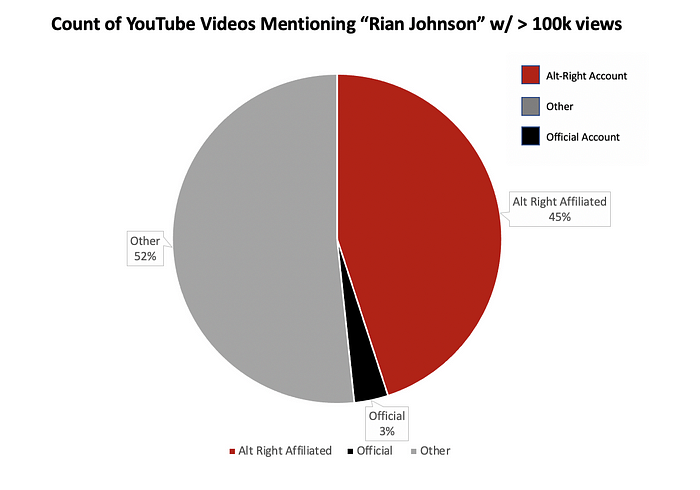
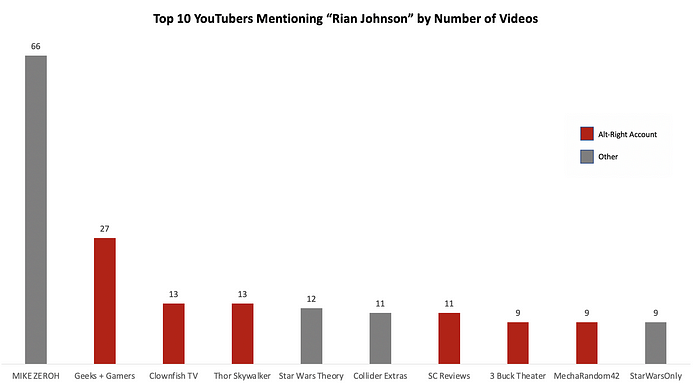
Other targets on YouTube have included Justina Ireland, author of Star Wars The High Republic: A Test of Courage, and Krystina Arielle, host of Star Wars: The High Republic Show, for tweets expressing their experiences as Black women in America. The tweets, which are critical towards white people, have been used to harass these women for being “anti-white.” One particularly vitriolic video from alt right YouTuber RK Outpost screams at* The High Republic host for being a “fucking racist” against white men. Arielle posted a small sample of the racist hostility that was sent to her following the videos from alt-right YouTubers.
Arielle was also targeted by Posobiec, who, if you remember, pushed hate against Boyega in 2015 before he was a known figure in the alt-right.
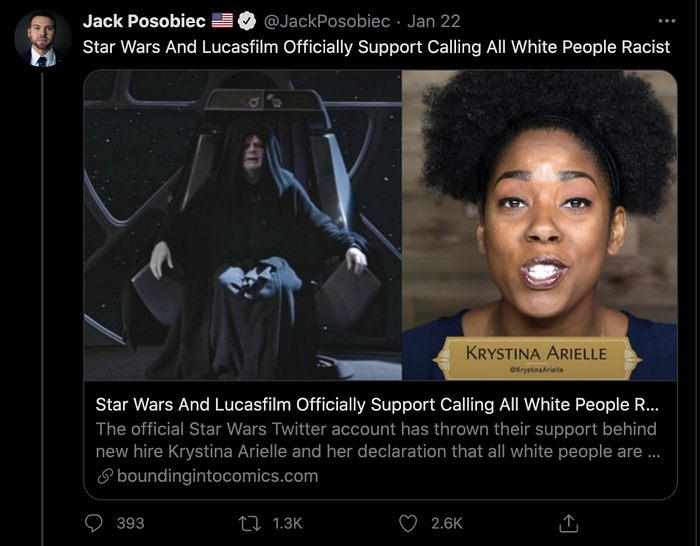
Posobiec has pushed other harassment campaigns from alt-right YouTubers in the Star Wars space, most notably the firing of Chuck Wendig, an author who was a writer for Marvel Comics at the time of the incident.
In 2018, Wendig posted a viral tweet thread that criticized calls for “civility” when dealing with right-wing extremism that landed him in a video by ComicArtistPro Secrets (Ethan Van Sciver). Wendig was then harassed on his Twitter account by Sciver’s followers. Wendig was abruptly fired from Marvel following the harassment. Posobiec approved of the firing in a now deleted Periscope.
The harassment was part of both ongoing Comicsgate harassment campaigns against progressive writers and a larger directive by the alt-right to attack liberal and progressive creators. The latter was also pushed by Posobiec, who was instrumental in the firing of Guardians of the Galaxy director, James Gunn.

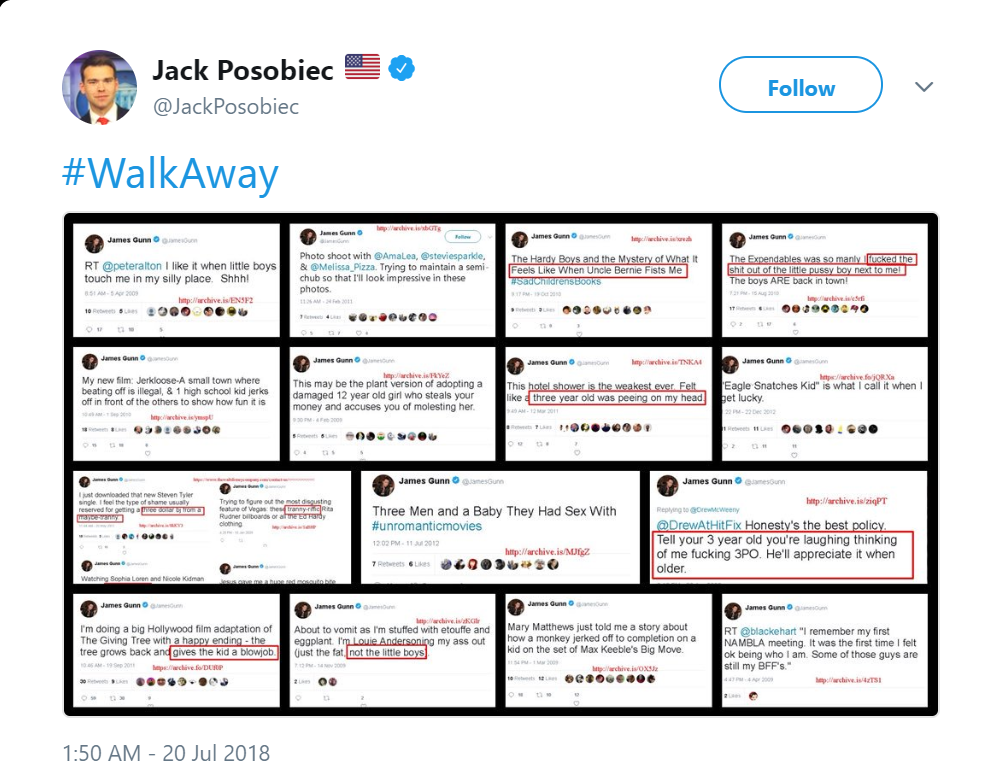
The most well known harassment campaign led by alt-right Star Wars YouTubers was the harassment of Kelly Marie Tran.
Tran has been a target of racist harassment in disturbing ways that spread across Instagram, YouTube, Twitter, and even her character’s fan wiki.
On Instagram, Tran’s posts were riddled with harassment telling the actress to “shut the fck up” and that she did “a terrible job” in The Last Jedi.
On Twitter, alt-right personality Paul Ray Ramsey posted a tweet making fun of Kelly’s body weight.
Lacina observed that “people use different language to talk about Star Wars and to talk about Rose Tico/Kelly Marie Tran. About 6% of SW/TLJ posts use offensive language. The rate of offensive language in posts about RT/KMT is double that: 12%. Hate speech was about 60% more common in tweets about RT/KMT compared to other Star Wars topics: 1.8% versus 1.1%.”
In one instance, Rose Tico’s Wookieepedia page was edited to read, “Ching Chong Wing Tong is a dumbass fucking character Disney made and is a stupid, autistic, and r — — — — love interest for Finn. She better die in a coma because she is a dumbass bitch.”
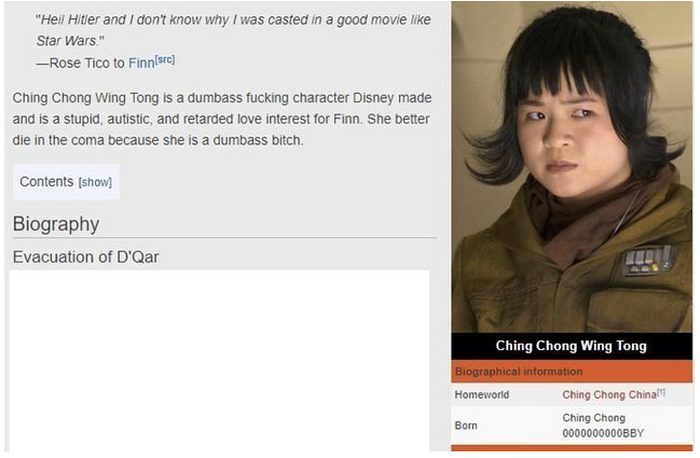
YouTube, however, carried the worst of the harassment.
Searching “Rose Tico” on YouTube will instantly bring you to negative and hateful videos towards the character. Almost 60% of videos mentioning “Rose Tico” with > 100,000 views are from alt right channels. Almost half of the top YouTubers by the number of videos mentioning “Rose Tico” are alt right channels. Sciver published 18 videos alone on Rose Tico.

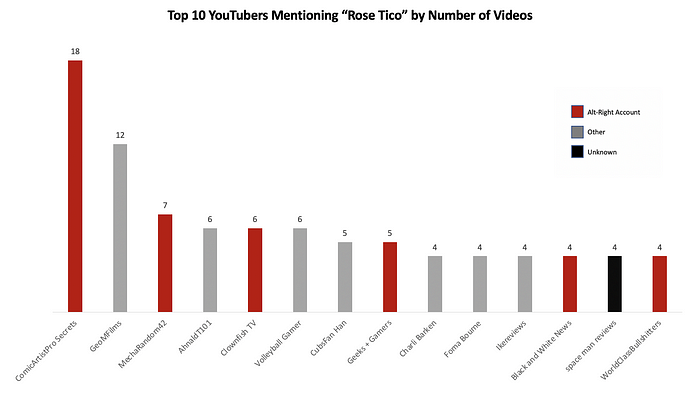
Watching videos about Rose Tico from alt right/”The Fandom Menace” channels is unsettling, to put it mildly. You’ll often stumble upon people wishing death towards the character. YouTuber “MauLer” in his review* of The Last Jedi refers to Rose as “Shrek” and practically growls “Shrek didn’t even have the decency to fucking die.”
One video entitled “Star Wars Sequels but Rose always dies” is 1 min and 40 seconds of scenes from The Last Jedi edited to imply that Rose dies in each scene.

The most disturbing video against Kelly Marie Tran and Rose Tico on YouTube is an hour long unboxing video* by ComicArtistPro Secrets where he seems to unbox dozens of Rose Tico action figures for one hour with no dialogue and only a soft piano track playing in the background. At points in the video, Sciver stops unboxing to stab and slice Tran’s action figures with knives and scissors. Sciver beheads the action figures several times.


A livestream on March 17th, 2021 titled “ZACK SNYDER disses THE FANDOM MENACE” includes comments from Sciver that suggest the hate against Rose Tico is racially motivated. In the livestream, Sciver discusses comments by Justice League director Zack Snyder given during a charity livestream for suicide prevention that Justice League: The Snyder Cut is not associated with Geeks + Gamers, who had a major hand in the charity fundraiser. Snyder also speaks out against the hate crime that occurred in Georgia in March 2021 where 6 Asian women were killed by a white gunman.
In response to Snyder’s remarks, Sciver states in a now removed YouTube video, “and to me, no, [Zack Snyder will] never stop me from killing Chinese people. Ever. I don’t care how many movies he makes.” Laughs are heard as Sciver speaks. Comicsgate supporter and YouTuber Jon Malin (who was also present on the livestream) echoes Sciver’s comments, asserting “we haven’t killed enough.”
Sciver continues, “give me a tommy gun and line em up against the wall, as the great Stan Lee once said.” Malin responds, ““hashtag nuke China, right?” “That’s right,” confirms Sciver.
The YouTubers “deflect” their obvious hand in enabling Tran’s harassment by declaring that they “love” Rose Tico.* They call themselves “Tico-paths” (there is even merch) and credit Sciver with “rehabilitating” her character before continuing to laugh at death wishes against her character.
In June 2018, Tran deleted her Instagram. She has not announced any plans to return to social media.
Mission Completed: The Rise of Skywalker Retcons The Last Jedi
In December 2019, after 4 years of highly coordinated racist and sexist hate against the trilogy, The Rise of Skywalker was released in theaters and noticeably retconned Rian Johnson’s The Last Jedi.
Before giving examples, it is important to note that the final installment of the Skywalker Saga was highly likely not any kind of malicious attack against progressive politics, nor was it some plot to appease white supremacists and anti-feminists.
Additionally, the vast majority of movie going audiences will not have the faintest idea of the hate that occurred within the Star Wars fandom since the release of The Last Jedi. Enjoying the film does not in any way mean that one agrees with white supremacists, alt-right reactionaries, and misogynists. However, that doesn’t change the fact that plot points that ended up in the film can be tied back to alt-right conversations on YouTube.
Some moments in the film that clearly included “fan theories” were inconsequential and were not taken purely from alt-right spaces such as the use of “Holdo maneuver” (a phrase used on Reddit and YouTube since 2017) or the moment when Luke raises the X-wing from the water in Ahch-To. Anybody who was deep within Star Wars fandom between 2016 and 2017 can tell you how often they heard that fan-favorite expectation (it was said a lot).
Then there are the moments that are troubling, but not egregious such as Snoke having a shoe-horned back story after fan “backlash” that Snoke died in The Last Jedi before anybody could deep dive into his life story (remember the Dave Rubin tweet?).
In another moment ripped from YouTube videos, Luke Skywalker catches his lightsaber after Rey throws it away from her and scolds her that “a Jedi’s weapon deserves more respect.” This is a direct response to online aggravation with Luke’s opening scene in The Last Jedi when he tosses the lightsaber over his shoulder. The Critical Drinker, who is in network with other “Fandom Menace” alt right YouTubers, has an especially popular video* on this “complaint.”
It is the decisions, however, that respond to anti-feminist and racist hate dutifully spread by fandom alt-right networks that make The Rise of Skywalker a distressing film to view.
What happens to Rey’s story is particularly unsettling. She ends The Last Jedi as a nobody who has been given the power to not just simply rebuild the Jedi Order, but to take the teachings of the Jedi in a new, enlightened direction. However, in The Rise of Skywalker, Rey no longer has power of her own. She is told that she has the power of her grandfather, Emperor Palpatine, one of the most recognizable and powerful villains in Star Wars canon.
In The Last Jedi, Rey confidently wields the Skywalker saber. There is a scene in the film dedicated to her understanding of how to use the saber’s power while a curious Luke Skywalker watches on. She later uses the saber to help defeat Snoke’s guards with the help of Kylo Ren. Her comfort with the saber acknowledges one of the most moving moments in The Force Awakens when the saber flies into Rey’s hand as the Force theme swells around her. All of this suggests that Rey is capable and worthy of one of the most iconic objects in all of Star Wars. However, in The Rise of Skywalker, Rey tells General Leia that she will “earn” Luke Skywalker’s saber, implying that she was undeserving of the saber the whole time.
Furthermore, all work that The Last Jedi had done to bring the Jedi Order into a new era was discarded. Instead, the Jedi are treated like deities that Rey suddenly follows with no questions asked, even after spending The Last Jedi attempting to beat Luke Skywalker with a staff.
In the end, Rey’s story concludes where it began: alone, in a desert. The final shot of the film is more for the audience’s enjoyment than for the character’s story as she stares into the binary sunset from A New Hope. Rey is ultimately reduced to a vessel for the past instead of a force for the future.
All of these decisions attempt to answer backlash against Rey’s character that can be found in alt-right* and radical right-wing videos. In these videos, alt-right YouTubers claim that Rey cannot be as strong as she is in the force without intense training or a powerful force connection to a (male) legacy Star Wars character.
Rey’s story was not the only one to be discarded in order for the narrative to focus on the nostalgia of the original trilogy. John Boyega’s character Finn is also noticeably squandered in the film and he is reduced to a side-kick helping Rey on a series of fetch-quests.
The Rise of Skywalker’s worst act, however, is reducing the screen time for Kelly Marie Tran’s character Rose Tico down to about one minute. While screen time does get cut often for all characters in films, it’s difficult to ignore the character’s absence after years of racist harassment against Tran and death wishes to her character. Given that many moments in the film appear to be direct responses to internet conversations and the reason behind Tran’s exclusion becomes increasingly and dreadfully apparent.
As I stated, all of these decisions were likely done without thinking about any of the potential consequences of the people that could be hurt or of the racist and sexist agendas these decisions inadvertently encourage. However, whether we choose to recognize the truth of the effective political attack against the Star Wars sequel trilogy or not, the final film in the Skywalker Saga is a perfect example of how difficult it is to identify the differences between genuine fan concerns and full-blown culture wars. It also demonstrates how vital it is for businesses and creatives to understand those differences. As it stands, the Star Wars sequel trilogy is an unfortunate testimony to the power of organized hate and the violent and vitriolic lengths that people will go to in order to stop cultural progress.
Of course, the alt right on YouTube were not happy with the film. They will not be satisfied until the sequel trilogy is never spoken of again. Only time will tell how the trilogy will move forward or be remembered.
In the meantime, there was one person who was pleased with this outcome.
What We Never Learned From Gamergate
It’s very easy to roll your eyes and say that everything I have written here is overblown. These are simply movies. You pay your money, you have your opinion, and you go home. Rinse and repeat. But, the reality is that we live in a world where a few very intelligent people are counting on you to think that way. And they will use that complacency to build the world that they want.
This is what Steve Bannon knew in 2014, and 7 years later, we are still being blindsided by the same strategy.
This was never about Star Wars, just as 7 years ago, it was never about video games. This plan of action will continue to move from one space to the next, hiding tactfully behind the illusion that these are just discontent fans voicing an opinion. And in each space, more and more people will be radicalized by the real existential threat that we are facing.
Technology is moving ahead of us at a pace our evolution is not equipped to handle. This means that those who can figure out how to exploit our inability to keep up with those advances will hold power that they never would have held otherwise. This is combined with a long, grueling history of hate, racism, sexism, and bigotry that we consistently fail to acknowledge and learn from as a society.
These two factors alone create a perfect environment where a minority of people can threaten the entire foundation of civilization and the majority doesn’t pay enough attention or doesn’t care enough to notice. After a very near decline of democratic power in the most influential nation on earth, that sentence shouldn’t sound extreme.
The danger presented here is what the “culture war” embodies. It is a swift and effective pipeline to hate and extremism that creates a larger resistance against progressive political change. If enough resistance is built up within society against progressive change, then that change will be blocked from happening. If the rights and representation of underrepresented groups are kept from culture, so it follows that they will be kept from politics. And, in the end, this is the goal.
I want to conclude this article with a quote from Deadspin written in October, 2014 that was included in an article titled “The Future of the Culture Wars is Here, and It’s Gamergate.” Kyle Wagner writes:
“What’s made [Gamergate] effective is that it’s exploited the same basic loophole in the system that generations of social reactionaries have: the press’s genuine and deep-seated belief that you gotta hear both sides. Even when not presupposing that all truth lies at a fixed point exactly equidistant between two competing positions, the American press works under the assumption that anyone more respectable than, say, an avowed neo-Nazi is operating in something like good faith.
And this is why a loosely organized, lightly noticed collection of gamers, operating from a playbook that was showing its age during Ronald Reagan’s rise to power, have been able to set the terms of debate in a $100 billion industry, even as they send women like Brianna Wu into hiding and show every sign that they intend to keep doing so until all their demands are met.”
In the time since this article was written, this event has not only replicated itself across every part of pop culture, but it has been used to help elect a dangerous bigot and bring a country to the brink of civil war.
If we choose once again not to pay attention, in 7 years, where will we be?
Please consider donating to the Southern Poverty Law Center, whose work battling racist alt-right extremism and hate in the United States is essential to the fight for human rights and progressive change.
EDIT: This article has been updated with a link of @VitoGesualdi’s tweet, which was mistakenly reported as deleted.
UPDATE: This article has been updated with comments from ComicArtistPro Secrets (Ethan Van Sciver) on a March 17th livestream seemingly inciting racist violence against Chinese people. It has also been updated to include information that the livestream video had been taken down by YouTube due to hate speech. Additionally, the description of Sciver’s 1-hour Rose Tico unboxing has also been updated to clarify that the video is edited to appear 1 hour long.
“Timeline of Outrage” graphic has been updated to include #yourslipisshowing
Zoe Quinn’s pronouns were updated after mistakenly using she/her pronouns instead of they/them.
About The Author
Rewriting Ripley is a bi-weekly podcast on feminism and fandom in the age of social media hosted by Katie and Lady V.
Methodology
Twitter Analysis
All twitter data was collected using a python script from Github that leveraged Twitter’s API. This article leverages three data sets:
- A historical sample of tweets mentioning “The Last Jedi” or “#TheLastJedi” between 12/15/2017 and 11/30/2018 (n=1,048,576). Tweets were originally pulled to compare tweets mentioning “The Last Jedi” with tweets mentioning “The Force Awakens” for research purposes only. Tweets were pulled periodically between September 2019 and April, 22 2020.
- A historical sample of tweets mentioning “#LastJediAwful.” Tweets mentioning “Last Jedi Awful” were removed from the data to focus on the hashtag. Remaining tweets included 6,436 tweets between December 29th, 2017 to February 13, 2021. Data is correct as of February 13, 2021.
- A historical sample of tweets mentioning “#BoycottSolo.” Tweets mentioning “Boycott Solo” were removed from the data to focus on the hashtag. Remaining tweets included 4,713 tweets between January 7th, 2018 to February 12, 2021. Data is correct as of February 12, 2021.
Data does not include tweets from locked accounts or tweets that have been deleted or suspended at the time of the data pull. Due to rate limits, limitations with historical API, and loss of data from deleted or suspended accounts, the population of tweets for #LastJediAwful and #BoycottSolo is likely higher than the current population. However, given the concentration of accounts tweeting the hashtag and the amount of times accounts have tweeted the hashtag, I am confident in concluding that these hashtags came from a small, but dedicated community.
Wordcloud and Sentiment Analysis
Keywords for sentiment analysis were retrieved from cleaning the twitter sample of tweets mentioning “The Last Jedi.” Tweets were cleaned in R and leveraged the libraries (library (tm)), (library(stringr)). Words were removed from the analysis including all stop words and “pic”, “just”, “wars”, “star”, “http”, “com”, “youtu”, “youtube”, “starwars”, “lastjedi”, “rianjohnson”, “last’, “jedi”, “twitter”, and “www.”
Top keywords were obtained from a wordcloud visualization created using (library(wordcloud)). Min. frequency to be featured in the wordcloud = 10,000.
Keywords where min frequency ≥ 10,000 were matched with a library of positive and negative words. These words were manually reduced to the final list based on manually reading samples of each word to see if their usage was neutral or positive/negative. For example, “better” is a positive word but was removed from the analysis since it could be used in the context “Rogue One is better than The Last Jedi.”
The final word list was used to analyze tweets in Tableau with the following calculation:
POSITIVE:
CONTAINS([Tweet], “loved”)
or CONTAINS([Tweet], “favorite”)
or CONTAINS([Tweet], “enjoyed”)
or CONTAINS ([Tweet], “love”)
or CONTAINS ([Tweet], “great”)
or CONTAINS ([Tweet], “best”)
or CONTAINS ([Tweet], “good”)
or CONTAINS ([Tweet], “amazing”)
NEGATIVE
CONTAINS([Tweet], “worst”)
or CONTAINS([Tweet], “hate”)
or CONTAINS([Tweet], “shit”)
or CONTAINS([Tweet], “bad”)
AND NOT CONTAINS([Tweet], “haters”)
AND NOT CONTAINS ([Tweet], “hater”)
Full keyword list can be found here in the tab “wordcloud_keywords.”
Sentiment Classification
Positive Classification: Tweet must have contained a positive keyword or explicitly expressed positivity towards the film. Tweets that could have been interpreted as defending The Last Jedi but did not express anything specifically positive towards the film (i.e. a film that only mocked people who disliked The Last Jedi but did not say anything specifically positive about the film itself) were classified as “neutral.”
Tweets from parody or meme accounts were classified as neutral even if they contained positive sentiment.
Negative Classification: Tweet must have contained a negative keyword or explicitly expressed negativity towards the film. Tweets from parody or meme accounts were classified as neutral even if they contained negative sentiment.
Unknown: Since sample is current as of April 22, 2020, several tweets have since been deleted or the account has been suspended. When sentiment could not be classified because the tweet no longer existed, it was classified as “unknown.”
Full sentiment classification can be found here in the tab “twitter_4222020.”
Political Affiliation
All affiliations were determined by basic information given by the user in their twitter bio, on their YouTube channel, or via a Google search of the user.
The following criteria was used to classify an account as “Alt Right/Radical Right:”
- The majority of the account must have been dedicated to pushing right-wing political ideology that included characteristics of alt-right or radical right wing spaces including anti-feminist rhetoric and targeting of female creators, targeting of people color or use of “anti-white” language, conspiracy theories, and/or excessive use of Gamergate era terminology such as “SJW.”
AND
2. Must be embedded in an alt-right/radical right network
OR
3. Must identify primarily as a radical right-wing account, be a known right-wing personality (e.g. Ben Shapiro) or identify as a member of “The Fandom Menace.”
“Embedded” is defined as having multiple connections to verified alt-right/radical right accounts (e.g. Jack Posobiec, Ethan Van Sciver, Mike Cernovich, Charlie Kirk). Accounts who were in network with verified alt-right accounts were not automatically considered “alt-right” accounts simply by association. The account must have been active in-network and pushing similar ideology. For example, YouTuber Star Wars Theory is in network with several alt-right YouTubers and has appeared in their videos. However, the account primarily makes neutral content on potential Star Wars stories. Since the account does not dedicate his channel to pushing political ideology, the account was not put into an alt right/radical right affiliation.
All affiliations for Twitter and YouTube samples can be found here.
If you would like more information on how this article classifies “alt-right” and how the definition has changed between 2014 and now, please listen to the second part of our podcast covering this article entitled “You Are Not Immune to Propaganda.” The section on defining alt-right starts at 00:42:27.
YouTube Analysis
All YouTube titles were scraped using an AI technique from the web scraping tool Scrapestorm. Scrapestorm identifies all information that comes up in a YouTube search and extracts that information into an exportable file (csv). This means that titles are scraped according to the algorithm and the titles within the number of pages that appear in a search are exported. If a video does not appear in a search for the search term (i.e. “The Last Jedi”), then it has not been included in this analysis. Therefore, this analysis does not include every YouTube video that mentioned a search term.
The following searches were pulled between January 7th, 2021 and January 16th 2021: “The Last Jedi”, “Rose Tico”, “Rian Johnson”, and “Kathleen Kennedy.”
Video information including view counts and video titles were pulled for 20 “anti-The Last Jedi” YouTubers by pulling pages of video data into Scrapestorm. Since it exported based on what was printed on the web page, view counts were exported as text and were converted into estimated counts.
To keep the analysis fair, videos were removed that weren’t relevant or that did not have the keyword in the title. This was done because the algorithm would pull videos that were about the topic but didn’t necessarily contain the keyword in the title.
Sentiment Classification
Positive Classification: YouTube videos were considered positive if they were either 1) a video explicitly expressing positivity about the film or 2) a fair review that ultimately ended with a positive perception of the film.
Negative Classification: YouTube videos were considered negative if they were 1) a video explicitly expressing negativity about the film or 2) a video discussing negative sentiment surrounding the film.
Sentiment classification for YouTube can be found here in the tab “YouTube_1162021.”
Political Affiliation
Please see “Twitter Analysis” section above.
